Katrina Kenison's Blog, page 2
November 21, 2020
comfort, conversation, and books to get us through
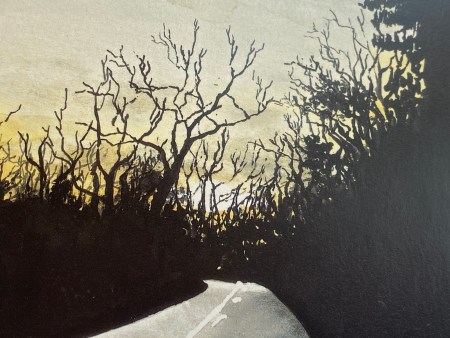 Winter is coming. And this year, even before the temperature drops below zero in New Hampshire, it’s already feeling colder and, let’s just say it, a good bit darker than usual. For many of us who have been lucky enough to be able to stay home since March, the sameness of the days has been a small price to pay for living with less risk. Over the summer there were actually weeks when I barely gave the pandemic a thought. With an ambitiously planted garden to tend, long walks to take, and leisurely family dinners to savor on the screened porch, it was possible to forget, every now and then, that we were homebound for a reason. Other than slipping on a mask to go the grocery store and washing my hands every twenty minutes (a habit now ingrained forever), life at home in July and August could resemble something close to normalcy, albeit a quiet, isolated normalcy. That, I know, was a matter of both privilege and luck.
Winter is coming. And this year, even before the temperature drops below zero in New Hampshire, it’s already feeling colder and, let’s just say it, a good bit darker than usual. For many of us who have been lucky enough to be able to stay home since March, the sameness of the days has been a small price to pay for living with less risk. Over the summer there were actually weeks when I barely gave the pandemic a thought. With an ambitiously planted garden to tend, long walks to take, and leisurely family dinners to savor on the screened porch, it was possible to forget, every now and then, that we were homebound for a reason. Other than slipping on a mask to go the grocery store and washing my hands every twenty minutes (a habit now ingrained forever), life at home in July and August could resemble something close to normalcy, albeit a quiet, isolated normalcy. That, I know, was a matter of both privilege and luck.
But with the virus surging across the land and cases in our small community on the rise for the first time, winter arrives this year with a menacing shadow. The other day my friend, gardener, writer, and popular podcaster Margaret Roach and I were chatting about how we might make it through this long season of short days, freezing temperatures, and doubled-down quarantine.
We discovered that we each aspire not just to survive these next few months, but to somehow rise up and meet their challenges with grace. To create good days at home, we agreed, would require a strategy. That means making sure we stay connected to small, tangible ways to take care of ourselves.
As someone with a bit of a prepper mindset, I’ve got the shopping part of my winter plans covered. There’s plenty of rice and coffee and toilet paper in the basement. I have long underwear and warm socks; there will be no excuses for not bundling up and getting outside in every kind of weather. That’s the easy part.
It’s the emotional demands of a long, fraught winter that will require a bit more advance planning. As always when I need to bolster myself, I turn to books. And although there will be no dinner parties, family get-togethers, houseguests, or evenings out in our future, I realize how much I’m looking forward to the opportunity to spend time this winter in the company of a few special books that feel like friends. I may or may not take a deep dive into a long novel come January. But right now, with so much loss and uncertainty in the world, I find myself reaching for books that simply offer comfort. Turns out Margaret has been doing the same.
And so we decided we’d continue the conversation we began on the phone on her popular podcast at A Way to Garden.
You can listen in here.
https://robinhoodradioondemand.com/podcast-player/18186/comfort-books-with-katrina-kenison-a-way-to-garden-with-margaret-roach-november-28-2020.mp3
For a full transcript, and to enter to win one of Margaret’s favorite books, the quirky and poignant memoir How to Catch a Mole, visit her site A Way to Garden.
As Margaret said, “It’s the week before Thanksgiving in the midst of a pandemic. No one is thinking about planting petunias.” It’s true. Instead we’re figuring out how to dial back even modest holiday plans, improvise on time-honored traditions, create more with less, and hunker down for the long haul this winter. With a little intention, we can nourish our spirits and turn our homes into spaces where we feel safe, content, and cared for.
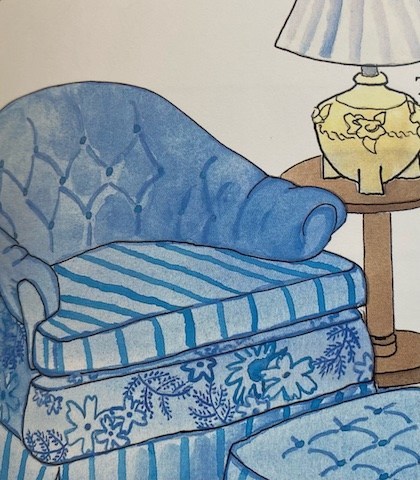 Making a list of books that inspire and console seems like a good place to start. Together Margaret and I came up with a companionable group of writers whose books are in some way a balm for hard times, reminders that our own attitudes and everyday choices have the power to make our lives happier, more fulfilling, and more in tune with what really matters.
Making a list of books that inspire and console seems like a good place to start. Together Margaret and I came up with a companionable group of writers whose books are in some way a balm for hard times, reminders that our own attitudes and everyday choices have the power to make our lives happier, more fulfilling, and more in tune with what really matters.
My own comfort list is as follows.
COZY: The Art of Arranging Yourself in the World by Isabel Gillies
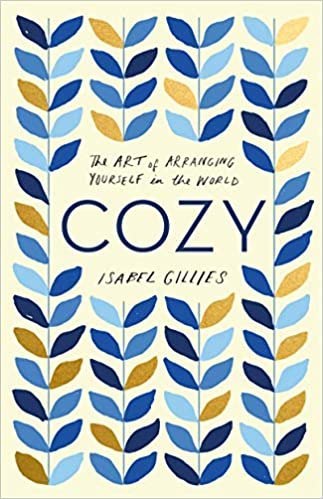 My husband read an excerpt from this treasure of a book in The Atlantic near the beginning of last March’s lockdown and was so charmed he immediately ordered a copy. (And I’ve just bought another one to give away to a lucky reader, details below.)
My husband read an excerpt from this treasure of a book in The Atlantic near the beginning of last March’s lockdown and was so charmed he immediately ordered a copy. (And I’ve just bought another one to give away to a lucky reader, details below.)
Cosy turned out to be the rare book that everyone in the family was happy to read. We even organized a dinner around the theme, complete with candlelight, comfort food, and written questions to answer and discuss.
Learning what makes each of us feel cozy turned out to be the perfect way to set a tone for the enforced intimacy that followed. How else would I have known that choosing a sweater vest to match his shirt each day makes my husband feel cozy? Or that my son Henry’s idea of coziness is seeing me pull out the KitchenAid mixer in the evening and set about making banana bread or muffins for the next day, something we now refer to as “after-dinner baking,” and which I’m much more inclined to do knowing it makes him happy.
When we talk about being cozy, most of us think of a favorite sweat shirt or a steaming cup of tea on a rainy afternoon. But Isabel Gillies suggests that coziness goes beyond mere objects.
To be truly cozy, she says, we first have to identify some truths about what makes us feel held, at ease, and at one with the world. And if we start to notice what feels cozy to us, and how we can create coziness for ourselves, then we can carry coziness into our day, bring more coziness into our lives, and know how to make ourselves cozy even in hard times.
HOME COOKING and MORE HOMECOOKING by Laurie Colwin
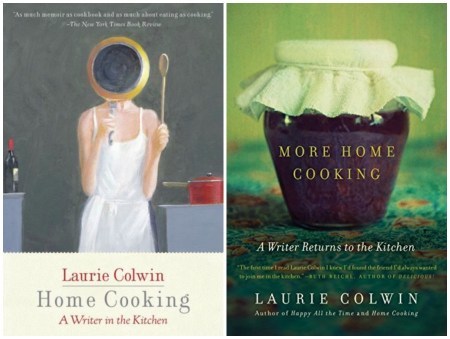 Ever since we started grocery shopping less often and eating every single meal at home, I tend to think about food morning, noon, and night. Many mornings I’ll read the front page of the New York Times and then turn straight to recipes to calm my nerves. My Ina Garten cookbooks have been in constant rotation since March. There’s been a lot of cheese.
Ever since we started grocery shopping less often and eating every single meal at home, I tend to think about food morning, noon, and night. Many mornings I’ll read the front page of the New York Times and then turn straight to recipes to calm my nerves. My Ina Garten cookbooks have been in constant rotation since March. There’s been a lot of cheese.
But for the feeling of having a best friend hanging out with you in the kitchen, there is no cosier, more encouraging, or more enjoyable companion than Laurie Colwin. When I was a young editor in New York in the ‘80s, Laurie was both a cherished acquaintance and hands-down my favorite writer; her stories and novels were at once intelligent, entertaining, and deeply touching, and I avidly collected and read them all. Later, as I negotiated the transition from single working woman picking up take-out on the way home from the office to a mom making dinner every night for a family of four, it was Laurie Colwin’s two beguiling collections of memoir-ish recipes that helped help me find my way. Laurie died in 1992 at the tragically young age of 48, but in the years since, Home Cooking and More Home Cooking have become true classics, inspiring a whole new generation of cooks and writers.
Laurie was never a person who went out much. She took pleasure in being home, in making do, in cooking simply and then squeezing in around a table to share a meal prepared with love. Her books are as much about eating as cooking, more about the pleasures of the kitchen than about creating perfection there, which makes her something of an anti-Martha Stewart and an ideal friend for these times. Yesterday, just before Margaret and I spoke, I paged through my time-worn paperback of More Home Cooking. There near the end was Laurie’s Thanksgiving chapter, with her recipe for Rosemary Walnuts, which I’ll be making next week. It reads as if it were written yesterday, except for the lines at the end, in which Laurie looks forward to one day traveling to her own daughter’s house for Thanksgiving and creating new traditions to carry on. Lest any of us need a reminder that life is precious, unpredictable, and can turn on a dime, there it is.
WHEN WANDERERS CEASE TO ROAM: A Traveler’s Journal of Staying Put by Vivian Swift
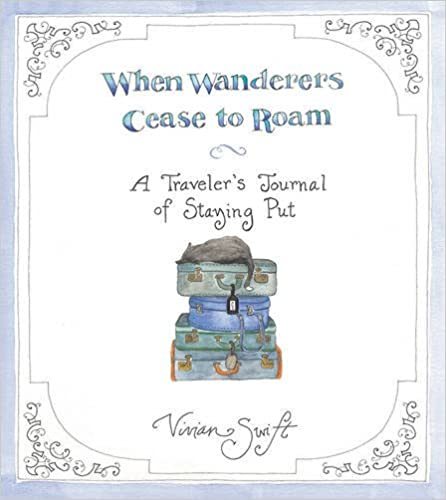 I’ve given Vivian Swift’s enchanting celebration of place to many friends over the last few years, especially those who, because of illness or injury, have found their lives severely curtailed. But now, of course, it’s the perfect book for everyone. We’re all staying put. Vivian Swift spent a lifetime trekking around the world; she had 23 different addresses in 20 years. And then, at last, she stopped moving, settled down in a small town, and began taking stock of her life and what it means to put down roots and call a place home.
I’ve given Vivian Swift’s enchanting celebration of place to many friends over the last few years, especially those who, because of illness or injury, have found their lives severely curtailed. But now, of course, it’s the perfect book for everyone. We’re all staying put. Vivian Swift spent a lifetime trekking around the world; she had 23 different addresses in 20 years. And then, at last, she stopped moving, settled down in a small town, and began taking stock of her life and what it means to put down roots and call a place home.
It’s impossible to convey the appeal of this hand-written, gorgeously illustrated, quirky and completely engaging book, but I can say that everyone I’ve given it to has fallen under its spell. Each page is a collage of writing, journaling, recipes, quotes from literature, odd bits of observation and natural history, and charming watercolors. The effect of it all is irresistible, a highly personal yet surprisingly universal ode to the joys of puttering, doodling, daydreaming, noticing. And every time I open it, I’m reminded that there is so much to see right here in my own home and outside my own window, even in the darkest days of winter. This might just be the coziest, most appealing book I know. It’s definitely the perfect book to curl up with on a cold December day.
KEEP MOVING: NOTES ON LOSS, CREATIVITY, AND CHANGE by Maggie Smith
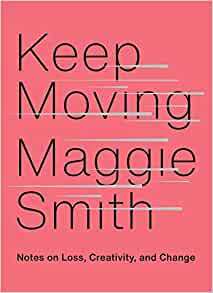 After all these months, I’ve formed some new routines that have made this strange, difficult time a bit better. One of those is attending to my sleep hygiene with more discipline. I’ve learned the hard way what not to do at the end of the day – scroll through Instagram, read the latest political news, or try to achieve Genius Level on the NYT Spelling Bee. And so, to settle down, I pick up a book. What I want once I’m tucked into bed, with only about five or ten minutes worth of mental energy left, is something short, reassuring, and easily assimilated — the grown-up equivalent of a bedtime story to gently transport my anxious mind to a place of peace.
After all these months, I’ve formed some new routines that have made this strange, difficult time a bit better. One of those is attending to my sleep hygiene with more discipline. I’ve learned the hard way what not to do at the end of the day – scroll through Instagram, read the latest political news, or try to achieve Genius Level on the NYT Spelling Bee. And so, to settle down, I pick up a book. What I want once I’m tucked into bed, with only about five or ten minutes worth of mental energy left, is something short, reassuring, and easily assimilated — the grown-up equivalent of a bedtime story to gently transport my anxious mind to a place of peace.
There are two small books that have taken up permanent residence on my pandemic bedside table. The most recent is Maggie Smith’s collection of luminous short reflections, Keep Moving. When Maggie’s 19-year marriage ended, and with it the life she had known, she spiraled into a depression so deep there were days, weeks even, when she could barely get out of bed or eat. She couldn’t produce poems during this time, but she did feel the desire to write.
“If everything was going to fall apart,” she told herself, she could at least create something. And so one day she wrote a goal for herself, just a couple of sentences, and posted it on social media. The next day, another. And so began her practice of writing a short, encouraging “note to self” – some kind of affirmation or encouragement or self-directive – every day. The question she found herself asking over and over was one I know all too well: “What now?” And the answer, always, inspired the last sentence of every goal she gave herself: Keep Moving.
Keep Moving is a book of both consolation and propulsion. It’s not lofty self-help advice, more like an encouraging friend whispering into my ear at bedtime, reminding me that I can do this, that this too shall pass, that I’m resilient enough to keep moving, come what may. Maggie’s voice may just be the one you want to hear at the end of the day, too. Keep Moving is one of those sneaky little books that confronts the truth of pain and grief head on, and yet leaves one feeling hopeful and encouraged that no matter how dark things may seem, there is something good waiting for us on the other side of loss. I’ll be giving a few of these for the holidays this year.
THE BOOK OF DELIGHTS by Ross Gay
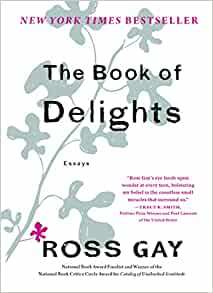 The other book I keep close at hand for those last moments before sleep is Ross Gay’s mind-expanding, gorgeously written collection of short essays about delight.
The other book I keep close at hand for those last moments before sleep is Ross Gay’s mind-expanding, gorgeously written collection of short essays about delight.
The premise is simple. Ross Gay is a poet, a passionate gardener, a Black man who does not gloss over any of the complexities or terrors of living in America at this moment. And yet on the occasion of his 42nd birthday he decided to set himself the task of writing every day about something that delighted him. The point was not to change the world, but rather to see if the very practice of noticing delight might in some way transform him. He chose to draft these short pieces quickly and by hand, and to think of the writing as a challenge to notice everything, to create room in every day for joy. Gay says it didn’t take long before he developed a kind of “delight radar.” And he also found there’s a lot to be said for the practice of flexing one’s delight muscle, especially in hard times. The more you look for and study delight, the more delight there is to study.
There is, I think, no better prescription for this moment than books that can help us steady ourselves on the shaky ground of 2020. Pandemic life is going to get harder before it gets easier. We could all use some support as we attempt to build on the mental and emotional skills we’ll need to keep going. Each of the books in my winter comfort stack are reminders of human resilience and of our innate capacities for kindness, joy, and observation. Together in spirit, we’ll spend this long winter staying home for the good of all. But at least we can make ourselves cozy as we journey in place. And what a gift it is, with so much at stake, to be carried by words into the hearts and minds of fellow travelers, seekers with whom we share a keen awareness of loss and pain, and, too, a commitment to stay open to all that is holy, ordinary, and beautiful in our lovely, imperiled world.
how to win a copy of Cozy by Isabel Gillies
I’ve purchased one copy of Cozy to give away. To enter to win, just leave a note in the comments section below. Answer any one (or all) of the “cozy” questions we asked at our family dinner table. I’ll draw a winner at random on Saturday, December 5.
When you think of your childhood, what cozy memory comes to mind?
What spot in your house is your favorite cozy place? What do you do there?
How do you create coziness when you’re all alone?
If possible, do consider purchasing these titles from your local independent bookstore. And if you prefer to order your books from Amazon, just click on each highlighted title above. (These are affiliate links.)
And do be sure to click over to Margaret and enter her give-away, too.
Stay home, my friends. Get cozy. Make soup. Cultivate delight. Keep moving and be well. We’re in this together!
(Both watercolors above are from Vivan Swift’s When Travelers Cease to Roam.)
The post comfort, conversation, and books to get us through appeared first on Katrina Kenison.
October 31, 2020
our time
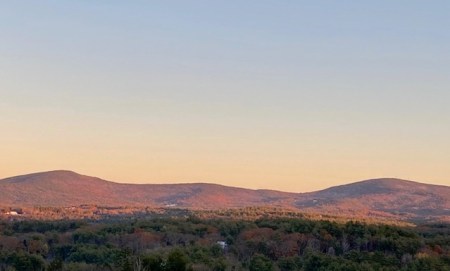 I stayed outside at dusk the other night for a long while, looking and listening, steeping in the rose-tinted mild evening air. The end of autumn is always poignant to me but it’s especially so this year. Perhaps you feel it, too.
I stayed outside at dusk the other night for a long while, looking and listening, steeping in the rose-tinted mild evening air. The end of autumn is always poignant to me but it’s especially so this year. Perhaps you feel it, too.
With so much uncertainty, loss, and anxiety in our world, we’re all a little frayed and tender. The one thing everyone seems to agree on is that we want whatever’s next to happen. We want next week to be over. We want the election behind us, we want all the votes counted, and the results to be fairly, legitimately resolved. We want, especially, to know which way we’re going.
No matter how things turn out, the road ahead will be hard. There will be more losses to come, more work to do, and so much grief and anger and failure to process. There will be chaos and confusion. I’m trying to hold onto faith there will be healing, too, and mending, and building. I try not to let myself get too hopeful. At the same time, I definitely do need to hope.
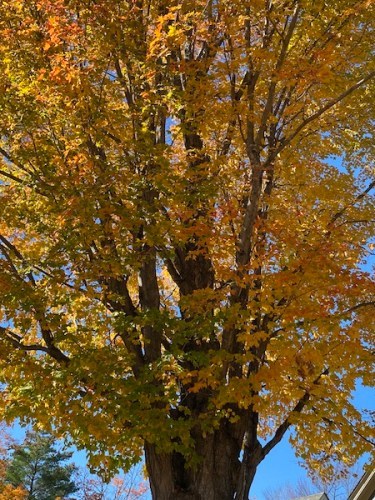 I felt quietly hopeful on that evening last week as I lingered in the yard watching the last light drain out of the sky. There were still golden leaves clinging to the maple tree that stands silent guard outside our kitchen and, for a moment, just before the sun went down, the leaves seemed to glow as if lit from within. That tree is as much a part of our days here as the view of the mountains, the hum of the freezer, the sound of the back door slamming shut. I know this old friend well – its graceful curves, the secret owl face hidden in the bark if you know how to look from just the right angle, the way the squirrels chase each other through the branches, the way the nuthatches travel headfirst down the trunk, foraging for insects.
I felt quietly hopeful on that evening last week as I lingered in the yard watching the last light drain out of the sky. There were still golden leaves clinging to the maple tree that stands silent guard outside our kitchen and, for a moment, just before the sun went down, the leaves seemed to glow as if lit from within. That tree is as much a part of our days here as the view of the mountains, the hum of the freezer, the sound of the back door slamming shut. I know this old friend well – its graceful curves, the secret owl face hidden in the bark if you know how to look from just the right angle, the way the squirrels chase each other through the branches, the way the nuthatches travel headfirst down the trunk, foraging for insects.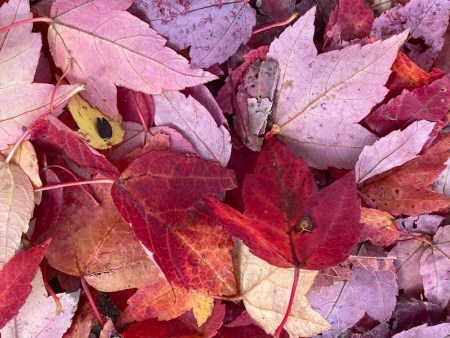
And, after days of raking, tarping, hauling, and mulching leaves, I also knew we weren’t quite done. Getting the yard and garden ready for winter is a long, physically demanding process. Always, the radiant maple is the last tree on this hilltop to drop its golden leaves, signaling the end of one season, the colder, darker beginning of another. Tomorrow, I guessed, or the day after, the maple, too, would finally, silently, undress. It is the last of October, after all.
As I stood there, sore and tired from a long afternoon of yard work but reluctant to call it a day and go inside and start dinner, the sky around me became suddenly alive with birds. First a few and then more and more arrived, as if summoned by some invisible bell. Swift and straight as arrows they flew, small black silhouettes in the shadows, approaching from all directions, slipping without pause into the maple’s sheltering branches until surely there were a hundred birds or more enveloped in the tree’s embrace.
The sight of all those birds winging their way home to roost filled me with awe. We have lived in this house for fourteen years and I’ve never once seen such a sight. And yet, for all I know, it happens every night. I turned at last to go indoors with my head full of questions. What kinds of birds were they? Would they all remain tucked in there together till dawn? Does this great homecoming migration happen all year long? How could I have missed it? And: what else am I not seeing?
In this year of staying home, my own roots in this place have grown deeper, my awareness of its rhythms heightened. The more I look, the more I see. The quieter I become, the more I hear. The slower I am, the more attuned I become to the eternal pulse of nature, to the slow turning of the seasons, the movements of animals, the cycles of life that sustain and shape and support us here on this mysterious, intricately balanced earth.
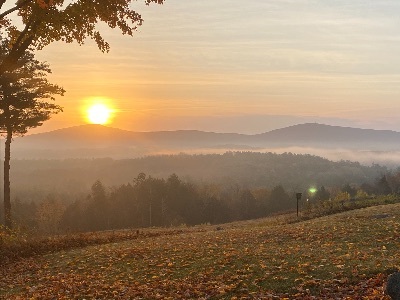 Lately I’ve found it almost impossible to sit still long enough to write more than a text or a grocery list. Every time I turn on my computer, I’m awash in a sea of words – entreaties for money for good causes, another batch of emails to answer, breaking headlines to process, polls and scandals and tragic Covid numbers to absorb, thoughtful articles and essays by writers I admire and long to read. And, too, a sense that there’s never enough time to give any of these things the attention they deserve.
Lately I’ve found it almost impossible to sit still long enough to write more than a text or a grocery list. Every time I turn on my computer, I’m awash in a sea of words – entreaties for money for good causes, another batch of emails to answer, breaking headlines to process, polls and scandals and tragic Covid numbers to absorb, thoughtful articles and essays by writers I admire and long to read. And, too, a sense that there’s never enough time to give any of these things the attention they deserve.
And I will confess: All of this writing, analysis, information, and projection only increases my jangled sense of overwhelm and anxiety. My fight or flight response quite often leads me away from the screen and straight out the door, where there is always physical, tangible work to be done — a garden bed to be cut back, pots to empty, another load of leaves to haul to the compost pile. And, too, where there is always beauty, silence, and a kind of holiness. At my desk, in my house, or staring at my phone, my heart is often heavy, my jaw clenched, my stomach flipping. Outdoors, though, it’s a different story. With the sky overhead and the earth beneath my feet, I become part of a larger narrative, a longer, deeper one in which my own place in things falls back into perspective. We humans are so small, so briefly here.
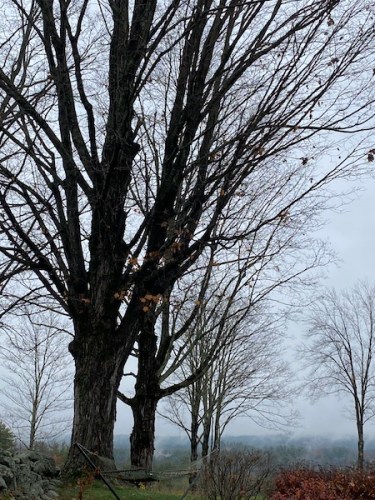 One way or another, we’re all white-knuckling our way toward Tuesday. I’ve probably made too many impulse donations to candidates I believe in, but I regret none of them. My husband, son, and I have written letters and held signs. In our small town, we’ll don our masks and vote in person. Beyond that, my approach during these last days has been to stay outdoors as much as possible. I can’t control the outcome of anything that matters, but I can keep the birdfeeders full. I can sweep out the shed, rake up the leaves, and pull out the petunias. I can stay grounded in the simple, necessary tasks of my own life. And I can look at the sky, at the now bare maple tree, at the snow that covers the ground this morning in a frosting of white, and trust in the forces at work in the world that are far beyond my own limited seeing and my own narrow understanding .
One way or another, we’re all white-knuckling our way toward Tuesday. I’ve probably made too many impulse donations to candidates I believe in, but I regret none of them. My husband, son, and I have written letters and held signs. In our small town, we’ll don our masks and vote in person. Beyond that, my approach during these last days has been to stay outdoors as much as possible. I can’t control the outcome of anything that matters, but I can keep the birdfeeders full. I can sweep out the shed, rake up the leaves, and pull out the petunias. I can stay grounded in the simple, necessary tasks of my own life. And I can look at the sky, at the now bare maple tree, at the snow that covers the ground this morning in a frosting of white, and trust in the forces at work in the world that are far beyond my own limited seeing and my own narrow understanding .
One day last week, I rounded the corner of the house pushing the wheelbarrow and was stopped in my tracks by the sight of fifty or sixty robins hopping about in the front yard, a gathering as uplifting to me as the determined crowd of citizens who have showed up downtown every Saturday all through the fall to stand in silent solidarity with Black Lives Matter, voting rights, and democracy. When we looked up from breakfast a few days ago to see a herd of deer just outside the window, they seemed almost like silent messengers sent to remind us that we share this time, this place, with others and that we’re all connected, for better and for worse.
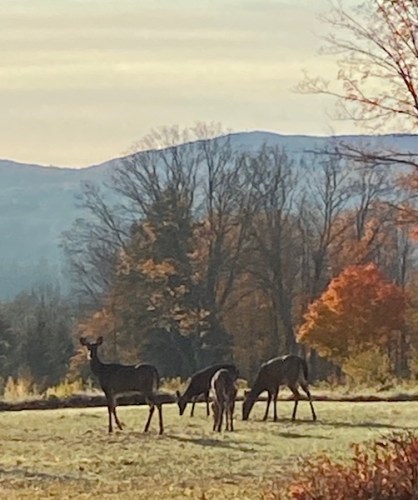 I stood in the garden one day last month surrounded by Monarchs; two weeks later, I watched a lone butterfly alight on a stalk of fading verbena, certain somehow this would be the last one until next year. I’ve watched chilled bees wobbling from one late-blooming cosmos to another. I’ve born witness to every sunrise, gazed at clouds, dug in the dirt, searched for the season’s last nasturtiums, made salads from the garden’s final gleanings, and potted up geraniums to carry inside for the winter. I’ve watched the landscape change from lush green to fiery reds and golds to brown and bare. As the last leaves drifted down, I was there to catch them. This morning I stepped outside and lifted my face to the year’s first snow. And then, as always, I headed back indoors feeling a bit more centered, a bit more able to take in the truth of everything else that’s happening at this fraught moment.
I stood in the garden one day last month surrounded by Monarchs; two weeks later, I watched a lone butterfly alight on a stalk of fading verbena, certain somehow this would be the last one until next year. I’ve watched chilled bees wobbling from one late-blooming cosmos to another. I’ve born witness to every sunrise, gazed at clouds, dug in the dirt, searched for the season’s last nasturtiums, made salads from the garden’s final gleanings, and potted up geraniums to carry inside for the winter. I’ve watched the landscape change from lush green to fiery reds and golds to brown and bare. As the last leaves drifted down, I was there to catch them. This morning I stepped outside and lifted my face to the year’s first snow. And then, as always, I headed back indoors feeling a bit more centered, a bit more able to take in the truth of everything else that’s happening at this fraught moment.
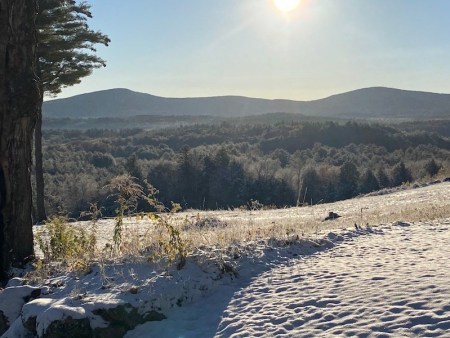 For today, even with so much at stake, I must summon some trust in the enduring cycles of things. Trust there will be both another spring in our future and healing in our country. Trust that somehow justice will prevail. There is so much we don’t know. And yet there’s also a kind of knowing, or faith, that comes with opening to what’s right here, right now. Paying attention means being reminded, again and again, of how transitory this all is. Change will come, one way or another.
For today, even with so much at stake, I must summon some trust in the enduring cycles of things. Trust there will be both another spring in our future and healing in our country. Trust that somehow justice will prevail. There is so much we don’t know. And yet there’s also a kind of knowing, or faith, that comes with opening to what’s right here, right now. Paying attention means being reminded, again and again, of how transitory this all is. Change will come, one way or another.
Although our waking hours may feel suffused with politics, pain, and outrage, the opposite is also true. There is energy and kindness and fierce commitment in every corner of our country. Good people are rising up. Together, we will breathe our way through this hard season and find our way into the next, whatever it turns out to be.
In the meantime, may we continue to take good care of ourselves and of each other. May we mend the part of the world within our reach, hold each other up, welcome every fleeting moment of delight, and embrace the mystery of being here for all of it. For this, dear friends, is our time. A time not of our choosing but the one we have been given, to make of what we will.
We Did Not Ask For This Room
We did not ask for this room,
or this music;
we were invited in.
Therefore,
because the dark surrounds us,
let us turn our faces toward the light.
Let us endure hardship
to be grateful for plenty.
We have been given pain
to be astounded by joy.
We have been given life
to deny death.
We did not ask for this room,
or this music.
But because we are here,
let us dance.
~ Stephen King (for the TV adaptation of 11/22/63)
The post our time appeared first on Katrina Kenison.
June 29, 2020
big love, small moments
 “It is when we are confronted with poignant reminders of mortality that we become most aware of the strangeness and wonder of our brief life on Earth.” ~ Kathleen Basford
“It is when we are confronted with poignant reminders of mortality that we become most aware of the strangeness and wonder of our brief life on Earth.” ~ Kathleen Basford
As I sit on my screened porch, looking out across the garden on this quiet, gray, end- of-June morning, it feels hard to break the stillness with words, even those I might write here. Over these last strange, sad months, as so much in our world has unraveled, writing blog posts about ordinary moments began to feel like an indulgence from a bygone era. There are so many wise, urgent voices that need to be heard right now. At the same time, there’s too much devastating news to absorb, too many losses to comprehend, and too many conversations swirling through the ether that do nothing to improve upon silence.
And so, for me anyway, this summer hasn’t seemed a time to be in the business of creating or posting, but rather a time to turn inward, to show up for my life and for my loved ones in a different way, to be saying less and listening more. It’s also been a time of deep immersion in the here and now. Perhaps it’s the stark truth of uncertainty, of loss, and of knowing we have no idea what tomorrow might bring, that inspires an even deeper devotion to the present moment. Or maybe it’s simply that staying home, staying put, and staying quiet creates more and more space in which to notice, and in the noticing we become more and more aware of just how precious and fleeting life really is.
I’ve spent a lifetime paying attention to the little things. And yet not until now has a cucumber’s slow progress from seed to salad, or a poppy’s sudden splendor, or the simple acts of taking a walk or sitting down to dinner with the family, filled my heart with such wonder, gratitude, and humility. Have the clouds always been so magnificent? Did greens from the garden always explode with such flavor on the tongue? Have there always been so many fireflies in June? Has my husband always been such a comforting presence as we turn out the lights at night, curl our bodies into each other, and slide into sleep? Would I have taken so much delight in the daily company of a bluebird at our kitchen window had I been racing to get to someplace else? Would I have wept so many tears when, after weeks of his constant presence, we found his bright, lifeless body underneath a peony bush?
Grief in one hand, joy in the other – this is our life now, isn’t it? As I struggle to comprehend the immeasurable suffering of so many at this moment, and, at the same time, as I find myself cherishing even more the moments we’re blessed to live, I’m reminded over and over again that attention is love. That love is always intertwined with loss. That there are no guarantees. And that, as long as I can soften, and open my heart to life as it is, guarantees aren’t really necessary. We’re here so briefly. How can we fail to be conscious of our treasures?
Over these last months, we haven’t strayed from home, except to spend the last two weekends at my parent’s house by the sea in Maine. Our lives have been both completely full and utterly simple, rooted in place. Steve goes into his office most mornings and has been able to shift a portion of his business online. Henry has been with us since early March, when his university closed down and he began teaching remotely from his old bedroom upstairs. At the end of May, my soul daughter Lauren left her home in Atlanta and drove 922 miles straight through to New Hampshire, where we welcomed her into our bubble with open arms. Slowly, carefully, our little group expanded when my parents, both in their mid-80s, determined they felt safe enough to visit and to enjoy meals with us. We’ve grown intimate here, sharing sunrises and sunsets, walks and talks, birthdays, the news of the day, the gardening chores, the laundry, the cooking, the dishes, happy reports at dinner, and the deep satisfactions and occasional challenges of living in such close and constant contact with each other and with nature, an unfailing source of solace, wonder, and awe.
To fully inhabit a home, a place, a life, a relationship is to discover that there are many forms of engagement, many ways to care for one another, and many ways to bring more love and compassion into a world desperately in need of tenderness.
I hope today’s short video, a gathering of small moments from the last couple of weeks, feels like a thread of love unspooling from me to you and bringing a bit of sweetness to your day. Inspired by the lyrics of JJ Heller’s lovely song “Big Love, Small Moments,” I wanted to create it simply as a reminder that sometimes just paying attention to the beauty at hand is the soul’s true calling. And I share it with you as a way of saying hello after these weeks of quiet, reweaving our connection in the knowledge that we’re all doing our best every day to be kind, to be present, and to cherish this fleeting, lovely life, right here, right now. Big thanks to Lauren for so artfully combining our photos with the music. May we all continue to walk this path together, unified by compassion and reverence for our wounded, wondrous world. This indeed could be the most creative work of all.
The post big love, small moments appeared first on Katrina Kenison.
April 18, 2020
an anniversary, a recipe, a gift
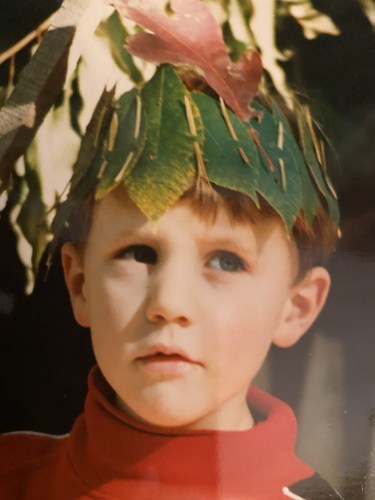 Twenty years ago this week, in a world quite different from the one we inhabit now, my first book was published.
Twenty years ago this week, in a world quite different from the one we inhabit now, my first book was published.
The title, Mitten Strings for God, was inspired by my son Jack, the rambunctious one in the family. Jack at five didn’t walk into a room, he slid or leapt or ran; he didn’t sit in chairs, he draped or clambered, sprawled sideways or hung upside down. He was a boy on the move. And I was his exhausted, impatient, frazzled mother.
One snowy day, as I sat crocheting mitten strings for all the boys’ surviving pairs, Jack was snuggled in close to me on the couch, finger-knitting his way through a lumpy ball of blue yarn. It was a rare oasis of stillness amidst the daily turbulence. We sat in silence for a while, doing our work. And then he looked up at me and said simply, “This is peace, isn’t it? I love this peace.”
Those innocent words filled my heart. They also gave me pause. Could it be that my son was in constant motion because I was in constant motion, too? Perhaps he needed a daily time-out as much as I did. And what if my real job as his mother wasn’t to rush him through the day, prodding and cajoling, trying to get to all the places we needed to go and to do all the things that needed doing, but rather to figure out a way to stay put and to do less?
As I finished my project, I asked Jack to show me his. He’d been sitting there, intent on his knitting, for over an hour. He held his creation aloft for me to see, all ten feet of it, and announced, “I made a mitten string for God.”
Over the last twenty years, we sold a house, bought a house, tore down a house, and built a house. Our two sons grew up, my husband and I grew old, and many possessions were jettisoned along the way. But Jack’s long blue mitten string hangs in my closet still. I see it every day.
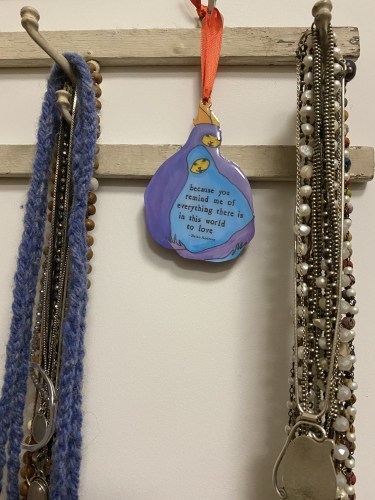 That piece of humble handwork, looped on a hook with my necklaces, is a symbol of my own small epiphany on that ordinary, long-ago afternoon. It will forever remind me of the moment I realized that, despite all my efforts to be a good mother, I had my priorities wrong. We could continue to pack our days with activities and then hustle to get through them. Or we could do less, stay home, and enjoy our lives more. We could begin to focus on what really mattered. Each other. The small moments. The little things. The coziness of a book read aloud, the freedom of an empty afternoon, the joy of make believe, the sweet intimacy of candles at the dinner table.
That piece of humble handwork, looped on a hook with my necklaces, is a symbol of my own small epiphany on that ordinary, long-ago afternoon. It will forever remind me of the moment I realized that, despite all my efforts to be a good mother, I had my priorities wrong. We could continue to pack our days with activities and then hustle to get through them. Or we could do less, stay home, and enjoy our lives more. We could begin to focus on what really mattered. Each other. The small moments. The little things. The coziness of a book read aloud, the freedom of an empty afternoon, the joy of make believe, the sweet intimacy of candles at the dinner table.
I knew so little then about who our boys would turn out to be or what might lay ahead for any of us. But thank goodness I did realize this: their childhood would be over before I knew it. Our days were fleeting, never to be lived again. If I didn’t slow down and pay attention, my sons would grow into young men and head off into their own lives, and I’d be left looking back, wondering where the time had gone. And so it was that our family life began to change. And I began to write about it.
I wasn’t thinking about any of this last month, as every shop and restaurant in town shut down, as we began washing our hands forty times a day, sanitizing cell phones and door knobs, and figuring out how to keep three adults fed without my typical daily run to the grocery store. There was a lot to learn at first, from meal planning two weeks in advance, to hosting Zoom yoga classes, to online banking, to how to fit a mask under my eyeglasses to keep them from steaming up every time I went outside.
And there was this: the constant, uneasy awareness that we are the lucky ones.
Tucked away here, in a house where three of us can shelter in place without ever getting in each other’s way, it feels important to keep sight of the horrific truths of the pandemic’s real toll. While we were lamenting the end of our comfortable routines and the cancellation of spring travel plans, millions of Americans were losing their jobs, their savings, their loved ones, their health, their lives. While our son Henry teaches his college classes remotely from his old bedroom upstairs, hundreds of thousands of others have no choice but to jam onto crowded subways and buses, risking their health in order to get to jobs they need in order to survive. While my husband pays the rent on his empty office and spends a few hours a day there shifting some of his dormant business to online sales, countless other small businesses are ruined for good, as years of hope and investment and effort vanish into debt, uncertainty, and loss. While my safely quarantined parents get the hang of joining us for dinner on Zoom, millions of our most vulnerable citizens are isolated behind closed doors in nursing homes desperately trying to keep their residents alive. And while I’m rummaging through the basement freezer for a package of chicken thighs, food pantries from coast to coast are overwhelmed by demands they have no hope of meeting. The photo yesterday of ten thousand cars lined up in San Antonio, with people waiting for hours for emergency food supplies, haunts me and fills me with a sense of helplessness, even as we send money every week to our own local chapter of End 68 Hours of Hunger.
It is one thing to linger at the breakfast table reading the grim news, trying to comprehend the staggering reality of nearly forty thousand Americans dead, three hundred million under stay-at-home orders, two million filing for unemployment. Not to mention the desperation, fear, suffering, and gross federal incompetence that underlie those terrible numbers. It’s quite another to experience that horror and grief first hand. I don’t personally know anyone who’s died. I’ve not been required to risk my own life. I won’t lose my home. And yet, even so, I dream dark, disturbing scenarios of infection and distress. My heart feels heavy, tender, as if swollen with some chronic inflammation of sadness that is both mine and not mine to bear.
Sometimes, when I drive through our deserted town and see all the dark and empty storefronts, I find myself wiping away tears. I miss the simple pleasure of strolling into Harlow’s with my husband on the spur of the moment, sitting at a high-top table surrounded by neighbors and friends, sharing nachos and drinking wine. What I’m mourning is not the loss of going out to dinner so much as the loss of life as we all knew it such a short time ago, the loss of community, of gathering, of breaking bread together and catching up in person. The loss of innocence, too, perhaps.
And then, quickly, I brush those tears away and continue on my way, to the little parking lot behind Roy’s Market, where my grocery order will be carefully packed and waiting for me on the loading dock, with my name written in black Sharpie on the paper bag, stapled with my receipt.
Honestly, who am I to cry?
Which brings me to this. I’ve been composing blog posts in my head for weeks. But every time I sit down at my desk, I end up asking myself the same question: Do people like me really need one more self-referential essay about how to have a good day at home, when home is a warm, welcoming place with food in the pantry, toilet paper in the bathroom, and the utility bills paid in full?
And yet, here we are, living our lives. Lives which do ask that we take notice, give thanks, and find some way to give back.
As I type these words my family is in the living room together, Henry reading on the couch and Steve in the big leather chair. (Jack, in Asheville, is still working, still healthy, fingers crossed.) An unseasonably late April snow falls softly. The woodpeckers come and go from the feeder, undaunted. There is fish chowder warming on the stove, a cornbread to make, the evening news to watch once the dishes are done. And in this moment, I’m challenged to somehow hold both the anguish of so many others and, too, to be fully present here, at the end of another quiet, uneventful day. I’m trying to pay attention to what’s right in front of me. And I also feel guilty about all of it.
I remind myself that to have empathy for another’s suffering is human and necessary, an urgent part of our work right now. But that is not to deny the small moments of grace that are also ours to experience. Grief and gratitude intertwined, as is so often the case. There is much to grieve in our battered world, and yet it seems that every poignant reminder of our own mortality is also an invitation to notice how much we usually take for granted, and to become ever more aware of life’s preciousness, its impermanence, its beauty.
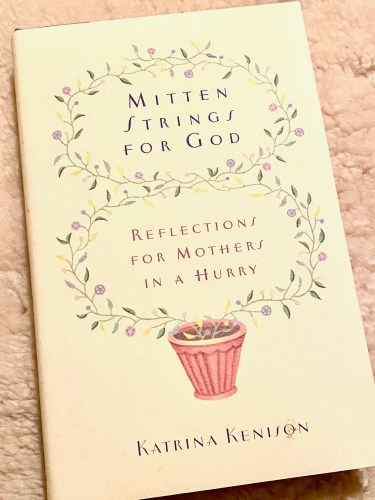 It’s been years since I opened Mitten Strings for God. Although I keep a copy on a high shelf in the kitchen, it seems a relic from another era, one in which my sons are frozen in time as the six and nine-year-olds they were when I was writing it. But lately, with so many days strung together at home, I’ve found myself drawn back to the simple rhythms my husband and I so deliberately established when our children were young.
It’s been years since I opened Mitten Strings for God. Although I keep a copy on a high shelf in the kitchen, it seems a relic from another era, one in which my sons are frozen in time as the six and nine-year-olds they were when I was writing it. But lately, with so many days strung together at home, I’ve found myself drawn back to the simple rhythms my husband and I so deliberately established when our children were young.
Back then, as we pared back our schedules, commitments, and our children’s activities, we discovered a kind of ease and contentment that had eluded us in the crush of going, doing, and experiencing. Less became more. In that pre-internet era we grew food, played games, read lots of books. Every other week, I made bread.
The other day, with time on my hands, I stood up on the kitchen stool, pulled down Mitten Strings for God, and looked for my old recipe.
What surprised me, as I riffled through the pages, was that I wanted to sit down and read more, as if these reflections written in the midst of mothering and learning to be more mindful, might actually have something to say to my struggling, overly emotional self right now. If I hadn’t glanced at the copyright page, I’d have missed the twenty-year anniversary. April 17, 2000. The fact that I happened to pull the book out on that very day, and that I did notice, feels like a sign of sorts.
And so, on this date that is meaningful only to me, it seems worth remembering that all our work matters, as long as it’s offered with love. Although a cure or a vaccine for the virus remains a distant hope, healing can happen in the here and now. Whether we’re alone in a room pouring our own thoughts onto a page or patiently teaching a child to read, words have the power to draw us closer. Whether we’re logging into an online conference call or phoning an old friend who lives alone or writing a letter by hand, connection erases the space between us. Whether we’re sewing masks at the kitchen table or treating patients in the ER or, as my son Jack is doing now, counseling recovering addicts who are trying to stay sober while their new routines unravel around them, we’re all part of a vast communal effort to help people get better. And whether we’re making yet another pantry dinner for the family, bringing pizza to nurses who haven’t had a decent meal in days, or donating funds to a local food pantry, feeding each other is a way of honoring the sacredness of all life.
We do what we can, from where we are, with what we have.
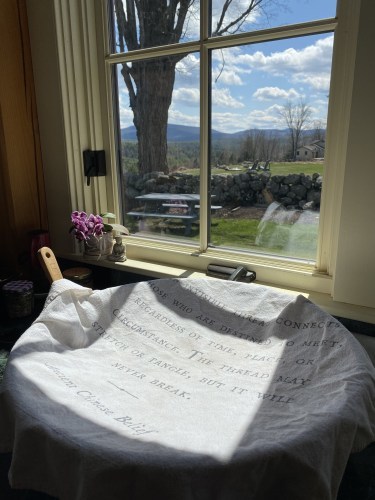 Baking bread is a small gesture. It’s also a gift that brings a little more warmth to our kitchen and a bit of unexpected cheer to someone else’s day. Although bread recipes abound, I’ve never found one I like more than this, the bread we lived on in simpler times and that I don’t think I’ll ever stop making, now that I’ve discovered it again.
Baking bread is a small gesture. It’s also a gift that brings a little more warmth to our kitchen and a bit of unexpected cheer to someone else’s day. Although bread recipes abound, I’ve never found one I like more than this, the bread we lived on in simpler times and that I don’t think I’ll ever stop making, now that I’ve discovered it again.
Here’s the recipe from Mitten Strings for God. There’s no kneading required, no sourdough starter necessary, no fuss whatsoever. There will be six loaves, which means you can surprise your neighbors with warm bread and still have some to tuck into the freezer. (We’ve been fortunate to have flour on our grocery store shelves, at least sporadically. I hope you can find some, or at least make a trade.)
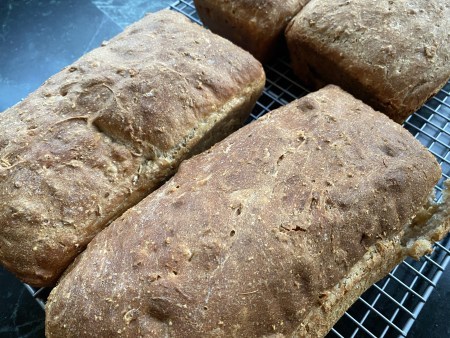
“Wonder” Bread
Combine in a very large bowl:
4 tablespoons canola oil
4 tablespoons honey
3 tablespoons sea salt or Maldon’s salt flakes
Add:
8 cups warm water
2 tablespoons yeast
Stir and wait 5 minutes, until yeast is dissolved.
Stir in:
7 cups organic white flour
6 cups organic whole wheat flour
1 cup organic medium-coarse stoneground cornmeal (I use Bob’s Mills)
2 cups organic rolled oats
When dough is well mixed (I use a big wooden spoon), scoop half of it into another large oiled bowl, cover both bowls with clean dish towels, and let the dough rise until doubled, about 1 ½ hours. Punch the dough down, either with your hands or your big spoon, and let it rise again, about 1 ½ hours. Divide the dough into 6 well-buttered pans and allow it one final 1 ½ hour rise, covered with dish towels. Bake the loaves on a middle rack at 400 degrees for about 40 minutes, or until the bread sounds hollow when tapped, rotating the pans midway through the baking to ensure even browning. Tip the cooked loaves onto a rack to cool slightly. And then, while the bread is still warm, slip a few loaves into paper bags and deliver them to your favorite people.
And finally, to celebrate the birthday of this small book that has continued to find its own way in the world for all these years, I’m giving away one of my very last hardcover copies of Mitten Strings for God, signed and personalized.
To enter to win a signed copy of Mitten Strings for God
Just leave a comment below. What are you grateful for? Or, what have you learned? Or, what do you miss? Or, what are you grieving? In other words, share a glimpse of what’s true for you right now. (Of course, you can also just say “count me in.”)
I’ll draw a winner at random at 12 pm EST on Friday, May 1.
Want to buy your own copy? I encourage you to do that here, through my beloved local bookstore, The Toadstool, in Peterborough, NH. (This will be a paperback.) I’ll be happy to sign your book before it’s shipped, and they will be happy to mail it to you. Although their doors are closed, The Toadstool is continuing to serve customers. And shipping is FREE. Let’s support our booksellers!
The post an anniversary, a recipe, a gift appeared first on Katrina Kenison.
March 16, 2020
the gift of an ordinary day
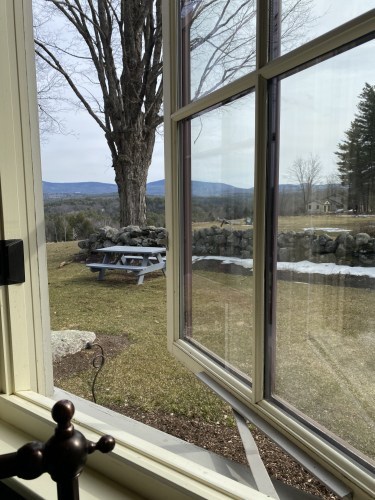 We were supposed to fly to New Orleans on Friday to meet our son Henry for his spring break. Instead, Henry was able to get a last-minute flight home to New Hampshire. He closed up his apartment in Tuscaloosa knowing he might not return till fall, shipped a box of books, filled two suitcases, and patiently listened to all my instructions about sanitizing his seat on the plane.
We were supposed to fly to New Orleans on Friday to meet our son Henry for his spring break. Instead, Henry was able to get a last-minute flight home to New Hampshire. He closed up his apartment in Tuscaloosa knowing he might not return till fall, shipped a box of books, filled two suitcases, and patiently listened to all my instructions about sanitizing his seat on the plane.
Henry’s senior musical theatre students were supposed to be in New York city this week, auditioning the numbers they’ve worked on all year before a roomful of agents and producers. Instead, they performed their pieces for their teachers and for each other on Thursday afternoon and sent a tape to New York. (The agents promised to watch, but that was then. Surely, by now, they are simply trying to survive.)
All semester, my son and and his cast for “Legally Blonde” have been rehearsing six nights a week for their April run. The spring musical in a musical theatre department is an enormous labor of love and dedication; for the seniors, it’s the culmination of four years of hope, effort, and intense study. The designers, the directors, the choreographer, the student actors – all had spent hours and hours getting this enormous show ready for opening night. There will be no opening night.
Instead, the cast gathered together one final time on Thursday evening and ran Act Two. They took to the stage and sang their hearts out, for the love of what they do and to honor the effort that’s gone into creating a show that will never be seen. And then they wept and hugged and said good-bye, knowing it was the last time they’d be together. Their four years of study and practice and late night rehearsals wouldn’t end with ovations and curtain calls, but suddenly, with tears and farewells and hastily made travel plans.
Meanwhile, I canceled the Airbnb place in New Orleans, the flights, the jazz brunch. Instead, I stocked up on pasta, rice, canned soup, and hand soap.
Saturday was unseasonably mild here, a breath of spring in the air, although I still went back inside for my hat and gloves. “We were supposed to be on the food tour right now,” Henry reminded me as we loaded fallen branches into the wheelbarrow. “Yes,” I said. “And instead we’re in Peterborough, picking up sticks and frozen dog poop.”
Given the pace of the virus spreading through our country, there is no place I’d rather be. To lace up work boots, head outside, grab a rake and begin the spring clean up here at home feels like a gift of normalcy in a world that’s suddenly become precarious, scary, and fraught with uncertainty.
Yesterday, we made waffles for breakfast and put on the Brandenburg concertos, the Sunday morning music of our kids’ childhood. Steve went to his office, to clean and go to the dump, and Henry and I hiked up Pack Monadnock. The parking lots in town were mostly empty, but not so the one at the base of the mountain. On our walk up, we ran into several friends and neighbors. People were eager to pause and chat, happy to connect from six feet away outside in the fresh air. We are all grasping at normalcy, it seems.
We stopped in to visit my parents on our way home, standing outside on the porch to talk through an open window rather than going inside. My mom passed her binoculars out through the door, so we could watch an otter hanging out on an ice floe on the pond, lazily snacking on a fish. If I could have held onto that moment, made it last, I would have. Instead, I simply tried to soak it up – the sun on our faces, my parents safely tucked inside their little house, my son at my side, the quiet half-frozen pond spread before us, a solitary otter enjoying its catch.
Back home, I set up a Zoom account on my iPad and texted Lauren in Atlanta to do the same. She and her room mate rolled out their mats and within a few minutes we had a cozy little yoga class going. It felt intimate and communal, as if we really were all together in the same room. The whole thing was unplanned, but as I asked them to lie down and close their eyes for shavasana, I wished I had something more to offer, a few words that might help us all calm down a little and remind us that even our “insteads” might have slender silver linings, if we’re open to seeing them.
I woke up early this morning, long before first light, wondering about what’s next. Just a week ago most of us were simply watching the news and living our lives, albeit with a slow-growing sense of anxiety. Now, seven short days later, we’re creating new lives in territory we barely recognize. The shift is invisible, profound, and utterly unsettling.
For me this last week has been mostly about upended plans and hasty homecomings, shopping lists and new hygiene habits, and making an abrupt adjustment from going and doing to staying and being. Meanwhile, everyone I know has been dealing with the confusion, disappointment, and the cost of canceled plans and trips, classes and work commitments. We all have family members displaced or in flux or wondering if a sore throat is something to worry about. We have loved ones in nursing homes who are suddenly inaccessible and friends in quarantine. Our routines are upended and our worries mount as we confront new bills, shrinking bank accounts, encroaching illness, and countless what-nows and what-ifs. And yet, so far, we are the lucky ones.
A vivid, intimately detailed story in the New York Times last week about two young health care workers in China brought home the devastating reality of the coronavirus for me in a way no chart or graph or headline possibly could. Both were twenty-nine years old, both were devoted young mothers with small children at home, both took every precaution against the virus as they showed up for work to care for the ill. Both became gravely sick themselves. Only one survived.
At this moment, no one in my own close circle is sick. But it doesn’t take much of a leap of imagination to understand that I, too, may lose people. Things are going to get harder. And sadder. In the meantime, like everyone else, I do my best to prepare. Buying some extra canned goods and soap is the easy part. New habits require diligence and practice, but I can do that, too. And there are plenty of ways to be productive at home. The closets, the basement, the garden – everywhere I look, a task awaits. On a practical level, I’m as ready as I can be.
The hard part, perhaps for all of us who are quietly turning inward at home this week, is figuring out how to ready ourselves for losses we can barely bear to think about. When we have no idea what’s next, or exactly how or when our own challenges will arise, the only sane choice is to practice staying present with life as it is right now. And the only thing we can know for certain is that life as it is will continue to be transformed, perhaps dramatically and tragically, in the weeks ahead.
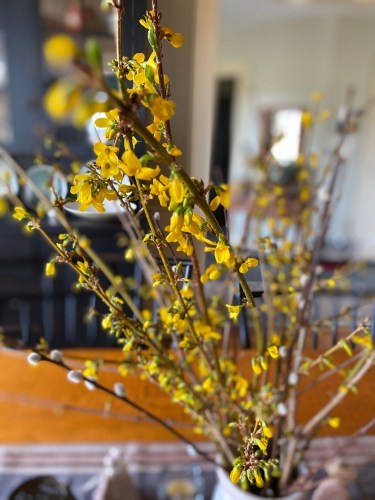 I’m sitting in my kitchen as I type these words, watching a familiar flicker come and go from the feeder just outside. The window is cracked open, and every now and then a solitary, unknown bird lets loose with a yearning call. Outside, the first daffodils are pushing through earth that was still frozen solid a week ago. The forsythia branches I cut on the last day of February and stuck in a vase are budding into yellow blossom, promising the arrival of spring. There’s food in the refrigerator and my family is safe. Looking around, everything appears completely the same as it’s always been. And yet, nothing is.
I’m sitting in my kitchen as I type these words, watching a familiar flicker come and go from the feeder just outside. The window is cracked open, and every now and then a solitary, unknown bird lets loose with a yearning call. Outside, the first daffodils are pushing through earth that was still frozen solid a week ago. The forsythia branches I cut on the last day of February and stuck in a vase are budding into yellow blossom, promising the arrival of spring. There’s food in the refrigerator and my family is safe. Looking around, everything appears completely the same as it’s always been. And yet, nothing is.
All over town, shops, restaurants, schools, and theatres are shuttered, empty, and still. Who knows when, or if, they’ll open again. My husband, owner of a small business, is at work today, meeting with his staff, confronting the stress of decisions that impact not only the lives of his employees, but their entire families and livelihoods, as well as ours. In Asheville, our younger son Jack is doing a double shift at the sober-living program where he works, with little choice but to show up and be useful during a time of high stress and increased vulnerability. Part of his job is to accompany clients to daily twelve-step meetings, but this week all those public gatherings have been canceled. Instead, they are holding their own meetings at the Next Step house, offering each other support even as newly established recovery routines are upended by closings and shut-downs.
There are no easy answers, no clear path through any of this, other than caution, kindness, and care for ourselves and others.
And so I remind myself: my real challenge right now is a spiritual one. In the midst of an evolving, unprecedented crisis, can I truly practice living moment to moment? Can I take on this strange new life day by day, from a place of tender awareness rather than fear? Can I let go of the ways I thought life would unfold and save my strength to swim with the tide? Can I stay focused on what’s good, right now?
I’m trying. We all are. And just as the virus that’s occupying our collective consciousness is invisible, so too is the love we put forth with every gentle word spoken, every note written, every phone call to a friend, every random kindness offered and received. I believe that in a time like this, once all possible precautions have been taken, love remains our most powerful antidote to fear and despair. We’re in this together, dear ones. Let’s stay home, even as we keep looking for ways to reach out and support each other. Let’s sanitize what we can and then seize every opportunity to notice beauty, to manifest joy, to create connection, and to keep and share the faith that, together, we will come through.
Fourteen years ago, as a cherished friend confronted the too-soon end of her life, I began writing notes for a book called The Gift of an Ordinary Day. I wanted to remind myself, as much as anyone else, just how precious an ordinary day can be. My guess is that none of us will ever again forget.
Pandemic
What if you thought of it
as the Jews consider the Sabbath—
the most sacred of times?
Cease from travel.
Cease from buying and selling.
Give up, just for now,
on trying to make the world
different than it is.
Sing. Pray. Touch only those
to whom you commit your life.
Center down.
And when your body has become still,
reach out with your heart.
Know that we are connected
in ways that are terrifying and beautiful.
(You could hardly deny it now.)
Know that our lives
are in one another’s hands.
(Surely, that has come clear.)
Do not reach out your hands.
Reach out your heart.
Reach out your words.
Reach out all the tendrils
of compassion that move, invisibly,
where we cannot touch.
Promise this world your love—
for better or for worse,
in sickness and in health,
so long as we all shall live.
~ Lynn Ungar
(As I was writing this afternoon, this poem arrived in my in-box, the daily offering from my friend Claudia Cummins’s much loved blog A First Sip. It speaks so exquisitely to the moment that I wanted to share it with you.)
The post the gift of an ordinary day appeared first on Katrina Kenison.
February 25, 2020
delight
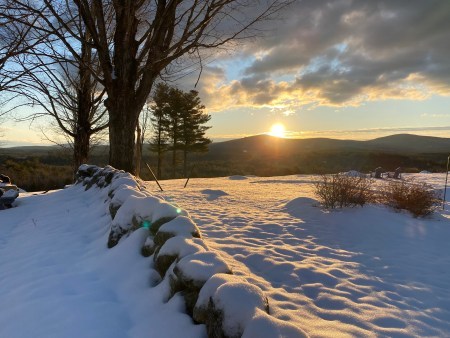 By the time I step out of the shower, my husband is already downstairs in the kitchen. The rich, cinnamon smell of French toast wafts up to the steamy bathroom, mixing with the scent of my citrus body lotion. The day awaits. But for a moment here, after I towel off and run a brush through my hair, I stand still, quiet, noticing everything.
By the time I step out of the shower, my husband is already downstairs in the kitchen. The rich, cinnamon smell of French toast wafts up to the steamy bathroom, mixing with the scent of my citrus body lotion. The day awaits. But for a moment here, after I towel off and run a brush through my hair, I stand still, quiet, noticing everything.
At the table, my husband has laid out a placemat for me, my cloth napkin in its ring. Dawn light pours through the tall windows. I measure out coffee, cut up fruit, choose a mug from the shelf, then step out into the yard for a moment to breathe in the clean morning air and listen to the woodpeckers banging away in the maple tree. Snow still blankets the ground, but something ineffable has tilted toward spring. There’s a promise of warmth beneath the cold, a releasing of winter’s grip on the land. You can feel it.
Inside, we sit as we always do, mostly silent over breakfast, reading the news on our iPads, exchanging a few words about the day’s grim tidings. There’s nothing hopeful to be found in the headlines. Crises multiply and intersect as the once unimaginable molts into reality – an intractable virus spreading through the world, Antarctica reporting record high temperatures; our election already under siege; a profane, partisan, self-serving president who lies viciously and flagrantly while denying any truth he doesn’t want to hear. The horrors seem at once urgent and, from the vantage of our own sunny kitchen table, oddly distant. “I almost don’t know how to absorb any more,” I say, pouring a second cup of coffee. “It’s all so disturbing and also kind of unreal.”
“Yes,” my husband agrees. “I know.”
And yet, on a bright winter morning, in this house, together, we are happy.
Somehow, both of these things are true. Things are bad. Things are good. And this, it seems, is the paradox of our time. Somehow we must learn to live with it. Is it possible to hold an awareness that much of our world is under siege while, at the same time, cultivating, nurturing, and expressing delight in its riches? Can we have empathy for those who suffer and, at the same time, allow ourselves moments of simple happiness when life is sweet?
“Despair is omnipresent,” a friend wrote this week. But so is goodness. In the midst of a dark, divisive time, we must remember that joy is possible, too. Not only possible, but necessary – a kind of radical and spiritually adept response to the complexity of the human condition. And perhaps our real challenge is to find a way to address everything that’s wrong while, at the same time, refusing to bow to either hatred or hopelessness.
I suspect I’m not the only one who wonders what it means at this dark moment to be a good person, a good neighbor, a contributing member of society? What does a good life look like? How can we be happy when so many others are struggling?
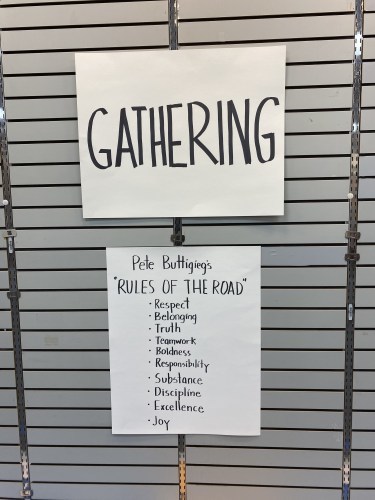 I believe there are as many ways to help as there are heads and hearts yearning for healing, truth, and justice. Still, considering what we’re up against, my own gestures seem small and insignificant: be kind, donate time and dollars to a campaign that stands for integrity and decency, knock on doors and make phone calls, write a letter by hand, make a meal for someone in need, engage in a conversation that attempts to bridge a divide rather than widen it. I feel better for doing what I can. And I know that, whatever I do, it will never feel like enough.
I believe there are as many ways to help as there are heads and hearts yearning for healing, truth, and justice. Still, considering what we’re up against, my own gestures seem small and insignificant: be kind, donate time and dollars to a campaign that stands for integrity and decency, knock on doors and make phone calls, write a letter by hand, make a meal for someone in need, engage in a conversation that attempts to bridge a divide rather than widen it. I feel better for doing what I can. And I know that, whatever I do, it will never feel like enough.
And so I must continually remind myself that although life itself can seem boundless, time is short. We’re on this earth but briefly, and it’s up to each of us, every single day, to find our own way to engage with it, both as celebrants of its beauties and as citizens who care about its future.
I’m grateful for the deep, daily pleasure I take in ordinary things. But I’m also aware of a constant, low-grade knot in my stomach, a combination of anxiety and sadness that comes of living nowadays, as so many of us do, with one other gnawing question: “Is this really the best we humans can do?”
As always when uncertain of my footing, I head this morning to my bookshelves and scan the spines. So many familiar old friends are there, patiently waiting, ready to be of use. I reach as if guided for a book I first read twenty years ago — a collection of quietly eloquent life-affirming letters by a young Jewish woman determined to maintain her faith and optimism even in the face of near certain death.
And indeed, I find in the pages of An Interrupted Life exactly what I need to hear. In one of her final letters from a Nazi detention camp in 1943, twenty-nine-year-old Etty Hillesum exclaims, “Despite everything, life is full of beauty and meaning.” These words, written in the most extreme circumstances imaginable, strike me as a kind of lamp in the darkness, an instruction to keep paying attention.
“Despite everything, life is full of beauty and meaning.”
And so it is — if, despite everything, I take time each day to see it.
I’m delighted at this very moment by the red-capped flicker at the bird feeder, gracefully extracting sunflower seeds through the mesh with its long slender beak. I’m delighted by the steady drip of melting icicles, by the warmth on the porch where I sit typing these words, by the play of light and shadow across the table. Beauty, when I pause long enough to notice, is always at hand. These days, it feels like both a responsibility and a privilege to be aware of how precious each moment really is, and to be grateful. To quote Etty Hillesum again: “Against every new outrage and fresh horror, we shall put up one more piece of love and goodness.”
Etty made a point of noticing, even in the transit camp where she spent her final days, the beauty that existed alongside incomprehensible evil. “The sky is full of birds,” she wrote. “The purple lupines stand up so regally and peacefully, two little old women have sat down for a chat, the sun is shining on my face, and right before our eyes, mass murder.” I have to pause and allow the extraordinary courage of those words to sink in. Etty Hillesum’s last letter was scribbled in haste; she tossed it from the window of the moving train that was carrying her to Auschwitz. It said only this: “We left the camp singing.”
It is odd, I know, to quote a concentration camp victim in an essay about happiness. But Etty Hillesum’s determination to see light in the darkness, and to comfort others with her delight in nature and her insistent faith in humanity’s goodness, is an inspiration to me at this moment. Her example suggests that to live well in this world is to honor its beauty even as we acknowledge its suffering. It’s to create peace where we are and to create wider and wider circles of peace as we can. And in these quiet moments of being, delight finds its way in. Delight is the love-child of attention. And attention is a potent and necessary antitote to despair.
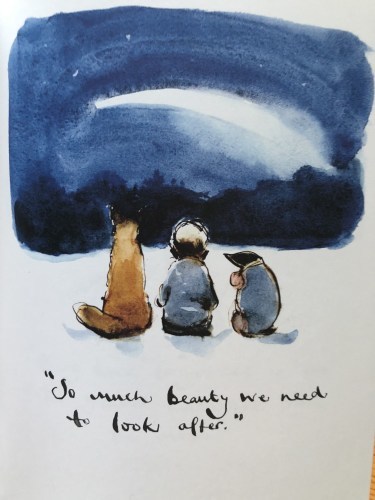 When my younger son phones to get some big-picture counsel about his next steps, I’m delighted to realize this is where we are now. What a miracle, really, that the two of us are finally able to talk so openly, to trust each other, to listen, both hearts soft. It delights me to say the words “I love you” and to know he hears them.
When my younger son phones to get some big-picture counsel about his next steps, I’m delighted to realize this is where we are now. What a miracle, really, that the two of us are finally able to talk so openly, to trust each other, to listen, both hearts soft. It delights me to say the words “I love you” and to know he hears them.
Throughout the morning, my mom and I exchange texts about today’s Spelling Bee in the New York Times, competing against each other to find the pangram that uses all the puzzle letters and to see who can attain “Genius” level first. I’m delighted that my favorite Scrabble partner is still on her game at age 82, and that she takes her own delight in waking me up at six a.m. to let me know she’s found fourteen words before sunrise.
On a walk, I’m delighted to chat with my soul daughter in Atlanta and especially delighted that, when I tell her I’ve been actively noticing and cultivating delight today, she offers to read me a children’s book she’s found about happiness. I climb slowly up the hill toward home with her beautiful voice in my ear, telling me a story.
“An old gentleman found it in a snowflake,” she says, “in the deep cold that came from distant lands. For just a moment, he thought that he was little again.”
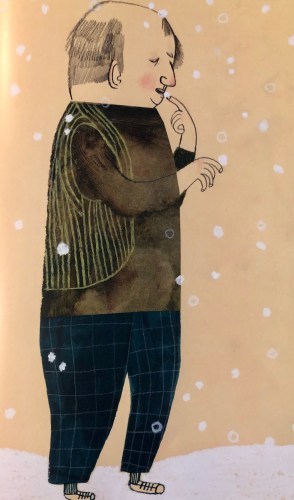 I tell her how much I cherish this long meandering phone visit, how happy I am being read to and catching up on a Sunday afternoon. “That’s what we do for each other,” she reminds me. “Collaborative delight.”
I tell her how much I cherish this long meandering phone visit, how happy I am being read to and catching up on a Sunday afternoon. “That’s what we do for each other,” she reminds me. “Collaborative delight.”
At the grocery store, an acquaintance greets me in the produce aisle and then steps in closer. “I want to give you a gift,” she says intently, completely surprising me. “Five minutes ago, as I was on my way over here, I saw a tree with a thousand robins in it. I had to pull over and stare at it. It was an amazing sight, like a miracle! Where did they all come from? Maybe, when you go home, they’ll still be there.” I didn’t take a detour to see if the robins had stuck around in that tree, but I didn’t really need to. For me, the delight was bearing witness to her delight.
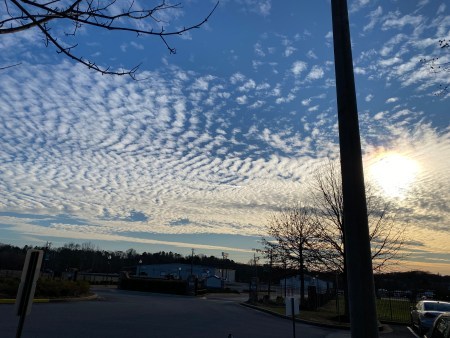 “Cool cloud cover here,” Henry texts in a family thread as I’m making dinner, along with a photo he’s just taken from the parking lot of his Tuscaloosa apartment. “Mackerel sky,” my mom writes back, attaching a link to the Wikipedia entry. And so I’m reminded of something else about delight: it grows when we share it. With each small act of noticing and offering, we sow a few seeds of happiness. What grows, then, is our own sense of interconnectedness and belonging. What blooms and flowers in that space is love.
“Cool cloud cover here,” Henry texts in a family thread as I’m making dinner, along with a photo he’s just taken from the parking lot of his Tuscaloosa apartment. “Mackerel sky,” my mom writes back, attaching a link to the Wikipedia entry. And so I’m reminded of something else about delight: it grows when we share it. With each small act of noticing and offering, we sow a few seeds of happiness. What grows, then, is our own sense of interconnectedness and belonging. What blooms and flowers in that space is love.
There is no denying the pain of loss, sorrow, fear, injustice, wrong-doing, violence, heartbreak. To be human is to hurt. But to be human is also to have an infinite capacity for hope and innate ability to see beauty in the world as it is. And in these bleak times, perhaps it’s as important to seek out moments of joy in our days as it is for us to carry the weight of all that needs fixing.
“Despite everything, life is full of beauty and meaning.”
Given the state of our fractured, imperiled world, it seems safe to say we’re in this struggle for the long haul. If we’re going to find the strength to carry on and to fight for what matters, we must also continue to celebrate what we love. To embrace delight, to dance with abandon, to soak up beauty, to share each day’s small gifts and doings, is to take care of ourselves and each other. So, if you should see a tree full of robins or a mackerel sky, be sure to tell someone. Your delight is mine.
In the spirit of sharing delights, here are a few more.
The Boy, the Mole, the Fox, and the Horse by Charley Mackesy
For Valentine’s Day, my friend Maude gave me a small book that continues to bring me both delight and deeper understanding. The Boy, the Mole, the Fox, and the Horse is a radiant, profoundly moving source of inspiration and hope for difficult times. To call it a fable or a story is to affix a label to a work that exists beyond labels. It’s really a heart offering. And Charlie Mackesy’s astonishing art says more about love and understanding than any written words could possibly express.
The Book of Delights by Ross Gay
On his 42ndbirthday poet and gardener Ross Gay decided he’d spend a year noticing and recording the small wonders and ordinary miracles we tend to overlook in our busy lives. Each day, by hand, he wrote a few paragraphs about whatever delighted him in the moment – a friendly wave from a stranger, pulling ripe carrots from the earth, a hummingbird at rest. The result is this small, intimate reminder that delight is where we find it, which is to say, everywhere. If you’d like a nudge toward delight, The Book of Delights will open your eyes and awaken your senses.
The Big Little Thing by Beatrice Alemagna
Lauren says she ordered this book after seeing an illustration on Instagram, without even knowing it was about happiness. And so, what a delight it was for her to receive Beatrice Alemagna’s poignantly evocative, slightly mysterious celebration of life’s small, fleeting wonders. And what a delight it is for me to pass the word along here. The Big Little Thing is ostensibly for children, but don’t be fooled. It’s for all of us.
This American Life: The Show of Delights
As so often happens when I’m open to what the universe has to offer, this delight was handed right to me. After writing all day, I slipped out for quick walk to clear my head. A friend had recommended an episode of “This American Life” about death, which I thought I’d listen to on my headphones. I couldn’t find it, though. Instead, up popped The Show of Delights. If you do only one thing for your heart today, listen to Act Two here, “The Squeals on the Bus,” in which a five year old boy does something delightful for the very first time: riding the school bus. The link to the entire (and entirely delightful) show is here.
(Note: these are affiliate links)
The post delight appeared first on Katrina Kenison.
January 18, 2020
pause, choose
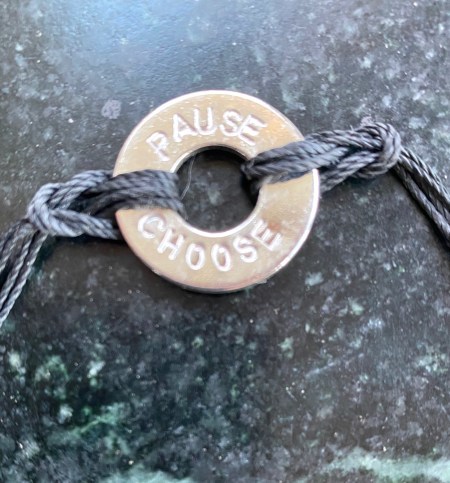 Between stimulus and response there is a space. In that space is our power to choose our response. In our response lies our growth and our freedom. ~ Viktor E. Frankl
Between stimulus and response there is a space. In that space is our power to choose our response. In our response lies our growth and our freedom. ~ Viktor E. Frankl
Snow falls softly as I type these words. We’re in the hushed depths of a New Hampshire winter here, eagerly noting each extra minute of daylight, resisting the urge to count the days till spring, still a bit astonished by the way a few inches of fresh powder so completely transforms the world beyond our windows. After three days of a nasty cold, I’m grateful for each unimpeded breath, for an hour in which I haven’t had to reach for Kleenex, for the progress that allows me to be upright at the kitchen table this afternoon rather than collapsed amongst the bed pillows.
As always during the first weeks of a new year, and especially over the course of these quiet, quarantined sick days at home, I find myself taking stock, reflecting on the inevitable parade of losses that is part and parcel of being in one’s sixties. And, too, I continually bow to an abundance of blessings. Life is rather beautifully becalmed in our family at this moment, which feels like its own kind of grace.
And yet. (There is always an “and yet,” right?)
Every day I’m reminded how fragile life is, how it can (and will) turn in an instant. My parents are both in good health, but they are also in their eighties; we live, each of us, with a heightened awareness of today’s preciousness. Meanwhile, so much in our community, in our country, in our world is unraveling. This morning I filled the bird feeders, watched the juncos gather eagerly for their seedy breakfasts, came in and brewed strong coffee, then sat down with my bowl of fruit and yogurt to read about the death of a billion animals in Australia. Such is the moment in which we live.
While protestors throng the streets in Iran, a snowplow slowly scrapes a clear path along our quiet country road. As new reporting reveals that the Russians are already deeply engaged in schemes to hack our 2020 presidential election, a friend in town tries to raise a couple of thousand dollars to turn an abandoned Radio Shack storefront into a local office for Pete Buttigieg. I write a check then tear it up and write a new one, doubling the amount, as if a few extra dollars, desks, and chairs could possibly make a difference. But we must hope, and we must act as if each small act of goodness matters. Which of course it does.
In Washington this week, 99 senators took an oath to “uphold impartial justice” as the impeachment trial of Donald Trump got underway. I wonder what each of those men and women thought and felt as they signed their names. I wonder if they paused to consider the full weight of the promise they were making and of the power they hold in their hands. I wonder if they each took a moment there, pen in hand, to consider the stakes of the votes they will cast, not only for our country but for their own hearts and souls and consciences.
In the evening, making dinner, I vacillate between tuning in to the evening news, by turns heartbreaking and infuriating, or turning away from it all so I can savor the cozy silence of my kitchen as it fills with good smells.
And I struggle, daily, to negotiate the disparity between my own comfortable security in this moment and the profound suffering of so many others. I’m not alone in this. The ever-present themes of fear, anxiety, despair, anger, and exhaustion are woven through our family text threads, countless conversations with my friends, and probing op-ed essays in the newspaper. It seems as if we are all both overwhelmed and numbed, longing for change and, at the same time, desperate for guidance as to how to make sense of the world as it is.
I don’t have answers to any of the questions I’m wrestling with these days. I don’t understand how, as mothers and fathers and sisters and brothers, we can turn our backs on those who are struggling just to survive. Or how we as a country can treat any human being as if he or she is somehow “less than” or not deserving of the rights we take for granted. I don’t understand our collective failures of empathy and compassion, both for one another and for our beautiful, beleaguered, planet. I don’t understand how values we as Americans once honored and upheld together, values such as integrity and truthfulness and fairness, were subsumed into partisan politics and a fight for power at any cost. But I worry that bit by bit we’re losing our capacity to see each other and ourselves as holy and worthy and interconnected. I worry that both hope and outrage can easily crumble into pettiness and complacency. I worry that in my own small way, in my own small life, I’m part of the problem.
At the same time, I want to believe we’re better than this.
“Be the change you want to see in the world,” Gandhi said.
And so I begin with me. I want to believe I’m better than this. No, I want to be better than this.
On New Years Day, my son Henry, my soul daughter Lauren, and I sat in the living room tossing around possible words of intention for 2020. Lauren passed her 2019 word, “trust,” on to Henry, saying it had served her well. He took it. “I want you to give me a word,” she suggested, and I didn’t have to ponder long. On June 1 the job she’s held for 17 years is ending. Two weeks later, she’ll turn 40. To mark both the closing of one door and the opening of some new ones, she’ll spend a month traveling in Europe before embarking on her search for a new career. “Curiosity,” I offered after a brief deliberation, happy to launch her on these explorations with an open heart and mind.
I’d been thinking about my own intention for 2020 for a while, and over these last couple of weeks I’ve realized that the phrase I committed to on New Year’s Day is at once a clear instruction, a reliable road map and, for me, a constant challenge. If I were the tattooing type, I would surely have these two words inked permanently onto the inside of my wrist: “Pause, choose.”
I suspect we might all benefit from the powerful force for good that a simple pause can create. Most of us will readily admit that we’re moving too fast, reacting too hastily, doing too much, texting and scrolling and tweeting too often, feeling and reflecting and thinking too little.
When I think about being the change I want to see in the world, I realize that my own best self is never the one who reacts in the heat of the moment, leaping in with both feet, swinging for the fences, speaking or acting without weighing the consequences, or rushing on to the next thing without fully considering what would serve me right now.
My best self is not the one who leans on the horn when someone cuts her off in traffic, or who hurries, eyes cast down, past the homeless person asking for a handout on the street. My best self doesn’t lash out in quick anger, or fire off a text or an email when her feelings are hurt, or presume a friend’s silence is a condemnation. She’s not the aggrieved victim who bites back when her husband makes a comment that stings. My best self doesn’t sulk, or turn icy cold, when she’s teased or criticized. She’s not impatient with someone else’s foibles or shortcomings or mistakes. She’s not the mom who lectures her son on the phone, the friend who offers unsolicited advice, or the neighbor who spreads a juicy bit of gossip. My best self isn’t quick to judge or criticize or second guess.
Nor is my best self the woman who’s so eager to please others that she ignores her own wishes and needs. She’s not the silent martyr trying to smooth the way for everyone else while growing exhausted and resentful in the process. She’s not numbing her own feelings, or silently berating herself for this or that dumb thing, or allowing someone else’s choices to determine her own well-being and happiness. My best self is not the person who agrees to commitments she’ll later regret, or who says “yes” because it’s just too hard to say “no.” She’s not the one who stays silent in the face of cruelty or injustice, or who fails to stand her ground for fear of being judged herself.
That impulsive, impatient, critical, overly sensitive, somewhat frightened, people-pleasing self is definitely part of who I am, though. And she’s the one I’m taking by the hand this year. I’m asking her to pause, multiple times a day, and to pay attention to what’s actually happening and how she’s actually feeling. And then I’m asking her to choose how she responds to life as it is in this moment, not from fear but from love.
Pause, choose. If I do it often enough, it’s bound to become a habit.
I believe that at the heart of many of the atrocities we see around us is a failure of compassion, a failure of empathy, a rush to judge and a haste to act. Cruelty toward one another and disregard for the earth itself comes from the loss of our imaginative capacity to recognize that we are all interconnected, that we are all holy, that we are all struggling, and that we are all one. When our capacity for compassion isn’t nurtured, when our sense of awe and interdependence and connection breaks down, when we distance ourselves from nature and divide ourselves into “us” and “them,” then hatred and violence become normalized.
I cannot change anyone else, nor can I do much to alter the course of world events. But I can call on my own best self to grow a little muscle and to develop a little more self-discipline. Hence, “pause, choose.”
My best self is the one who continually steps into that invisible space between stimulus and response in which Viktor Frankl so astutely recognized an opportunity for growth and freedom. Somehow, each of us must find a way to live with the fact that goodness and evil, suffering and joy, mundanity and beauty all coexist in this complicated, precarious, contradictory world. It’s up to me, to each of us, to find a way to make of our own lives an offering, a blessing, a gift. Simple kindness seems like as good a place as any to start.
And so in this year 2020, I’ve given myself the humble yet rather profound challenge of being less reactive and more intentional. Less emotional and yet more aware. Less sensitive and yet more compassionate. Moment to moment, day by day, in big ways and in small ones.
When I envision the self who embodies the concept of “pause, choose” I see someone who feels her own feelings, even the uncomfortable ones, before acting on them or shutting them down. In the heat of a moment, she takes a deep breath. She defuses the tension rather than adding to it. She gives the other person the benefit of the doubt. She waits a minute or two or twenty before doing or saying anything at all. She listens attentively, actively, with her whole being. She doesn’t interrupt. She is patient. She has a way of finding the humor in the hard times, the light in the dark, the beauty in the loss, the grace that is almost always part of grief. She steps out of her own shoes so she can slip into someone else’s. She speaks with care. She cultivates peace rather than stirring up conflict. She isn’t afraid to be wrong, to be vulnerable, to be seen. She clears space in the day for quiet, for solitude, for reflection. She turns off her phone, closes her computer, and gazes out the window, allowing her own thoughts to come and go. She pays attention to the intuitive, quiet voice inside that says “do this, not that.” She creates beauty in small ways and finds meaning and purpose in small doings. She is kind. She holds her dear ones close and lets them know they are seen, valued, and loved, exactly as they are.
These may sound like pretty modest ambitions in the face of all that’s wrong in the world. And yet to really commit to “Pause, choose” could result in a kind of quiet transformation. These two words together seem to offer a path toward healing, toward freedom, toward a deeper understanding of what it means to take better care of ourselves and of each other. When I remind myself to “Pause, choose,” I’m really reminding myself that what I do and what I say and how I act in any given situation brings either positive, useful energy into the world, or its opposite. Pause, choose. Imagine what could happen if everyone did it.
Today, may you choose peace. May you not
make war with yourself, your family, your world.
May you choose calm over chaos, acceptance
over aggression, and surrender over struggle.
May you be kind to your body, and thankful
for how steadfastly it carries you through life.
May you be attentive to your mind,
and grateful for how clearly it guides you.
May you dwell fully in your good heart,
which only aches to be tender and true.
Today, may you to learn to make peace
with each delicate moment, just as it is.
And may your quiet, unconflicted presence
serve to soothe and enliven the whole world.
~Claudia Cummins
(Note: Some of you have asked about the “pause, choose” bracelet. A gift from Lauren, it arrived serendipitously in my mailbox yesterday, just as I was finishing this essay. You can find MyIntent.org., the small company that turns words and intentions into jewelry, here.)
The post pause, choose appeared first on Katrina Kenison.
October 5, 2019
a birthday, a book, a gift
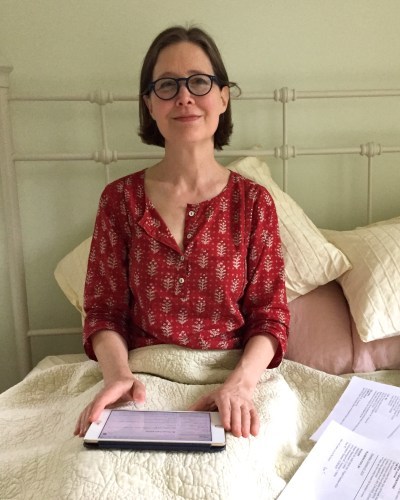 For my birthday this year the universe gave me Ann Patchett.
For my birthday this year the universe gave me Ann Patchett.
And my joy and gratitude is such that I’m going to pay the gift forward by passing Ann Patchett on to you.
If you’re a regular reader here, you know I’m more likely to spend a week reflecting, revising, and rewriting a post than to share a few hasty sentences dashed off on the fly. (That will never be my way.)
But what is a birthday if not an opportunity to change things up a little?. So, hello from the Baltimore Airport. I have about forty minutes before I board a plane to Atlanta, a good incentive to write fast and cut to the chase.
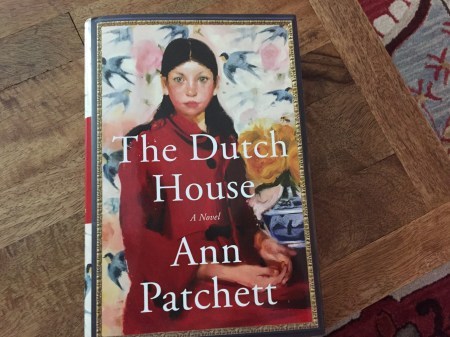 If you’ve turned on your car radio, opened the newspaper, or perused the front table at your local bookstore over the last week or so, chances are you’ve heard Ann’s voice or seen her new novel The Dutch House stacked in best-seller-sized piles. The publication of any Ann Patchett novel is cause for celebration and delight, but The Dutch House has already ignited a special kind of buzz, the kind of excitement that fills auditoriums with eager fans, has people lining up at signings with armloads of books to give to friends, and has its beloved author in demand from coast to coast.
If you’ve turned on your car radio, opened the newspaper, or perused the front table at your local bookstore over the last week or so, chances are you’ve heard Ann’s voice or seen her new novel The Dutch House stacked in best-seller-sized piles. The publication of any Ann Patchett novel is cause for celebration and delight, but The Dutch House has already ignited a special kind of buzz, the kind of excitement that fills auditoriums with eager fans, has people lining up at signings with armloads of books to give to friends, and has its beloved author in demand from coast to coast.
When I noticed that Ann’s two-month-long book tour for The Dutch House would have her speaking in Brookline, Massachusetts, one night and in Concord, New Hampshire, the next, I thought she might welcome a short break from hotels and hired drivers. “Yes!” she replied to my email offering her two nights in our guest room, black tea and avocado toast, our dog Tess to pat, and my services as chauffeur.
It’s said that when one door closes another opens, and my friendship with Ann is a case in point. She was the final guest editor of my sixteen-year tenure as series editor of The Best American Short Stories, a job I loved so much it almost didn’t feel like work, and a job I was deeply saddened to lose due to corporate decisions beyond my control. The publication party that year of 2006 was bittersweet. There was a cake for me and a set of sixteen leather-bound volumes, and there was also Ann Patchett herself, in Cambridge to host the evening’s selected readings. Thrilled as I was to meet her at last, after a year of letters and long phone conversations in which we debated the merits and failings of dozens of stories, I was also struggling to hold it together. It was hard to say a graceful public good-bye to my editing career, which was ending so abruptly and confusingly. At some point during the cocktail hour, Ann slipped her arm through mine. “This is terrible,” she said. And then, despite having known me for all of fifteen minutes, she whispered, “I’m not leaving your side.”
Later that evening as we prepared to untangle our arms and part ways, Ann cemented the deal. “I like you so much,” she said. “Even though the book is done, we should still be friends.” And that was that. We still are.
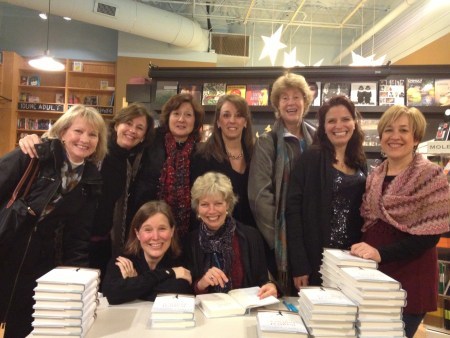 When my memoir Magical Journey was published, Ann invited me to Nashville to read at Parnassus . And when I told my book group where I was going, they decided to come along to cheer me on. Ann being Ann, she invited all eight of us to dinner at her house. It was a magical evening and the conversation was spirited but here’s the one detail we all remember: while Ann was in the kitchen putting the finishing touches on the meal, her new little dog Sparky hopped onto the dining room table and sat down in the fruit bowl. (This was nearly ten years ago; it should be noted that Sparky has grown up to be an impeccably behaved dog who would blush at the memory of such a faux pas.)
When my memoir Magical Journey was published, Ann invited me to Nashville to read at Parnassus . And when I told my book group where I was going, they decided to come along to cheer me on. Ann being Ann, she invited all eight of us to dinner at her house. It was a magical evening and the conversation was spirited but here’s the one detail we all remember: while Ann was in the kitchen putting the finishing touches on the meal, her new little dog Sparky hopped onto the dining room table and sat down in the fruit bowl. (This was nearly ten years ago; it should be noted that Sparky has grown up to be an impeccably behaved dog who would blush at the memory of such a faux pas.)
My own connection with Ann has deepened over the years, but that story can wait for another time. Right now I have a novel to give away. Suffice it to say that my book group was once again there in force on Tuesday night when Ann addressed a sell-out crowd in Brookline, and she remembered every one of my friends. That’s the way she is.
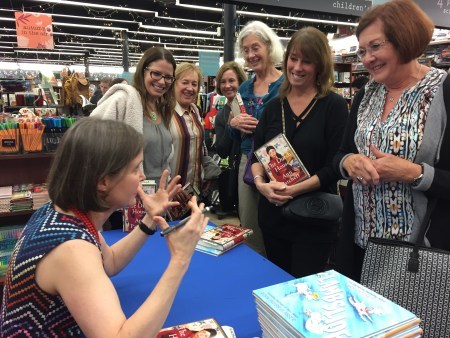 It’s always a pleasure to have a dear friend installed in our guest room, but sitting down to a bowl of oatmeal with Ann this morning and talking over breakfast about books we’ve read and people we know and life as it is for each of us these days was about the loveliest way to begin a birthday I can imagine.
It’s always a pleasure to have a dear friend installed in our guest room, but sitting down to a bowl of oatmeal with Ann this morning and talking over breakfast about books we’ve read and people we know and life as it is for each of us these days was about the loveliest way to begin a birthday I can imagine.
Although I read an advance galley over one long July day, for the last week I’ve been listening to Tom Hanks perform the audio version of The Dutch House – an immersion which has at times made me feel more like a member of the Conroy family than my own. And at each of Ann’s events I’ve learned a bit more of the surprising back story of how this deeply imagined and completely engrossing family saga came to be written – including Ann’s realization as she read through the finished first draft of her book that she needed to throw the whole thing away and start again from scratch. “It was a really bad book,” she admitted in front of a theatre full of readers. “Fortunately, no one but me ever saw one word of it.”
I asked her this morning if she’d considered, at that moment, just starting an entirely different novel.
“Oh no!” she said, “I was so interested in these characters, and in what happens to them, that I was really excited to go right back into their world and to get it right. By the time I started writing the book for the second time, I knew them all so well that I just had to step back and let them be themselves.” Little wonder then that this wonderful novel, which writer Mary Laura Philpott aptly describes as “the Patchett-est of all Patchett novels” feels at times more like a work of truth than fiction.
The publisher describes The Dutch House this way:
From the New York Times bestselling author of Commonwealth and State of Wonder, comes Ann Patchett’s most powerful novel to date: a richly moving story that explores the indelible bond between two siblings, the house of their childhood, and a past that will not let them go. The Dutch House is the story of a paradise lost, a tour de force that digs deeply into questions of inheritance, love and forgiveness, of how we want to see ourselves and of who we really are.
And indeed, it’s these intertwined themes of love and forgiveness, of the stories we tell ourselves to survive and the stories we must be willing to revise in order to move forward, that keep The Dutch Houselingering in my mind even as I’m busy doing other things.
Not surprisingly then, at each stop along the way this week I’ve thought of more people I wanted to buy copies for. It’s the sort of novel you want to press into the hands of every reading person you know. But having watched Ann sign about a thousand books in the course of two days, I hesitated to place another stack in front of her at the breakfast table. This, however, is the beauty of a birthday: you get to ask for whatever you want. Of course, Ann was more than happy to sign a book for me and one for a lucky reader, too.
And then it was time to go. We went outside to have one last look at the chrysalis, which was translucent when we checked it yesterday, revealing the bright, compressed body of the monarch within just waiting its moment to emerge. While we were eating oatmeal and signing books, a butterfly had flown. That seems fitting somehow, like a good omen upon turning sixty-one.
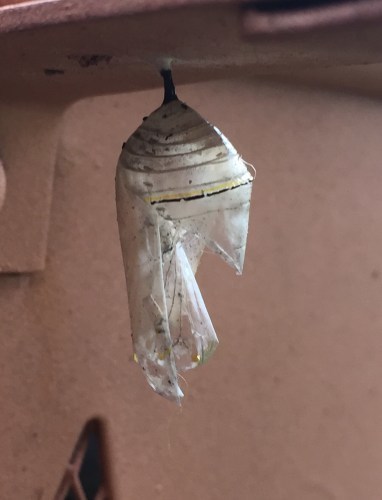 My mom came over to say happy birthday and good-bye, and I handed her a stunning floral arrangement to take home.
My mom came over to say happy birthday and good-bye, and I handed her a stunning floral arrangement to take home.
“These are from Yo-Yo Ma,” I explained. “He was in the audience on Tuesday night in Boston and he brought these flowers for Ann, who brought them to our house in New Hampshire, and now, because we’re both leaving, they’re for you.”
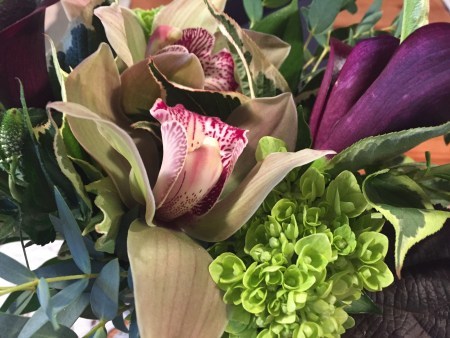 This is the kind of magical thing that happens when the universe gives you Ann Patchett for your birthday – you get to give your mother flowers from Yo Yo Ma. And I get to give away one personalized copy of a novel that will work its way into your heart and haunt your imagination long after you turn the last page.
This is the kind of magical thing that happens when the universe gives you Ann Patchett for your birthday – you get to give your mother flowers from Yo Yo Ma. And I get to give away one personalized copy of a novel that will work its way into your heart and haunt your imagination long after you turn the last page.
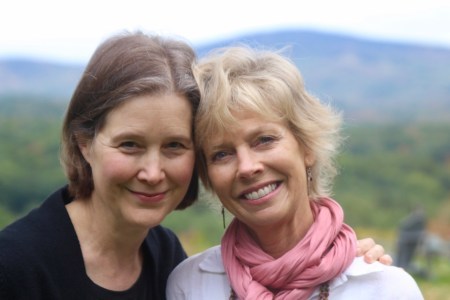 My husband Steve took a few last photos, I gave Ann some peanut butter cups for the road, my dad drove us to the airport, and Ann and I hugged and went our separate ways – she to Washington, D.C. to address another crowd of eager readers, and me to a birthday dinner with my soul daughter and a swing through the south to visit each of my sons.
My husband Steve took a few last photos, I gave Ann some peanut butter cups for the road, my dad drove us to the airport, and Ann and I hugged and went our separate ways – she to Washington, D.C. to address another crowd of eager readers, and me to a birthday dinner with my soul daughter and a swing through the south to visit each of my sons.
Ok, time to board here in Baltimore. Happy reading, my friends.
How to win a personalized copy of The Dutch House
Just leave a comment in the comments section below. What are you reading this fall?
I’ll draw one winner at random after midnight on Sunday, October 20.
You can find Ann’s entire tour schedule here. And while you’re visiting her website be sure to check out her book recommendations, an eclectic and surprising list that will keep you reading for months.
Want to order signed copies of The Dutch House? Do that directly from Parnassus Books, Ann’s bookstore in Nashville. Or, visit your own local independent bookstore. The Amazon link is here.
The post a birthday, a book, a gift appeared first on Katrina Kenison.
September 25, 2019
first day of fall
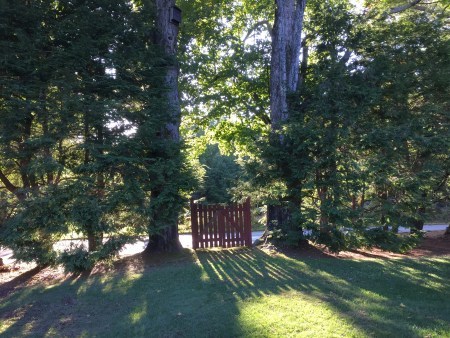 Come down to the back patio,” my neighbor Debbie texts.
Come down to the back patio,” my neighbor Debbie texts.
“30 minutes,” I reply. “Am on the phone.”
“I’ll wait,” she types back. “Important.”
I finish chatting with my son and walk out the kitchen door. Although it’s only four, the sun is low and the day feels all but over. The trees are dappling, as if dappling is what the trees are here to do. For the first time, I see a scattering of leaves on the ground, portent of the carpet to come.
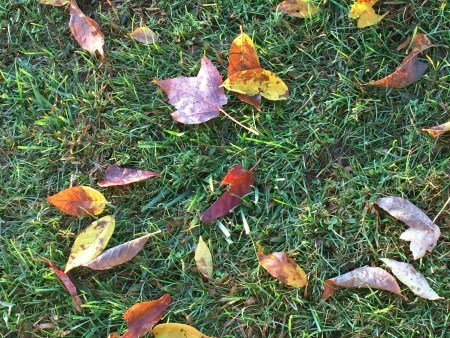 Ferns that were lush and green on Saturday morning have turned to bronze by this Monday afternoon. The air, though warm and still, seems to breathe the end of summer, each breeze an exhalation of endings. There’s no single word to describe my feelings on this first day of fall, a sense of loss tangled with gratitude, of sadness stirred with wonder, awareness, longing, hope.
Ferns that were lush and green on Saturday morning have turned to bronze by this Monday afternoon. The air, though warm and still, seems to breathe the end of summer, each breeze an exhalation of endings. There’s no single word to describe my feelings on this first day of fall, a sense of loss tangled with gratitude, of sadness stirred with wonder, awareness, longing, hope.
Although my friend is waiting for me, I pause in the garden to look around. I’ve been gone only two days yet everything seems different — softer, quieter, the urgency of growing and blooming slowed now in the golden light of an autumn afternoon. A monarch flutters past, landing on a swaying spire of purple-top verbena. Suddenly I realize the air is alive with butterflies, wobbling silently amongst the flowers with their delicate stained-glass wings, touching briefly down on zinnias, sedum, and their beloved verbena, drinking deeply from each chosen blossom as if offering benedictions.
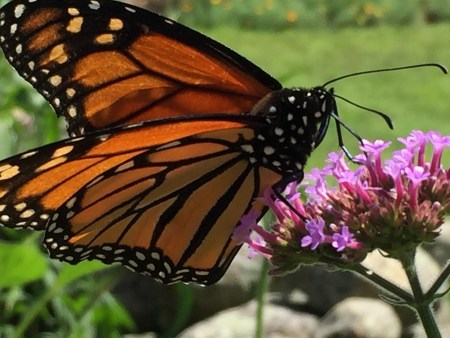 Always at this time of year, as the days grow shorter and the heart-shaped morning glory leaves collapse upon themselves, my own heart grows heavy with the weight of memory. Two dear friends began their slow exits from the world in Septembers past, as if the change of seasons was the cue their own bodies had been waiting for. Come September, I remember the bittersweet final days I spent with each of them, how each in her own quiet, determined way undertook the work of letting go, allowing life to give way inexorably to death.
Always at this time of year, as the days grow shorter and the heart-shaped morning glory leaves collapse upon themselves, my own heart grows heavy with the weight of memory. Two dear friends began their slow exits from the world in Septembers past, as if the change of seasons was the cue their own bodies had been waiting for. Come September, I remember the bittersweet final days I spent with each of them, how each in her own quiet, determined way undertook the work of letting go, allowing life to give way inexorably to death.
Now, here, older than either of them ever were, I think of all they’ve missed. And, too, I marvel at the way life goes on. I did not suspect, twenty autumns ago as Lisa and I ran together, panting and talking and laughing as we urged each other to push for one more mile, that I would grow old without her. I couldn’t have imagined, as Diane and Carol and I planned the menu for a festive Harvest Dinner one long-ago September afternoon, that our threesome would become two, or that in 2019, nine years after her death, Carol and I would carry on our friend’s legacy by rising in the dark on a fall Sunday to join a dedicated group of fellow walkers on the Jimmy Fund Marathon to raise money for ovarian cancer research.
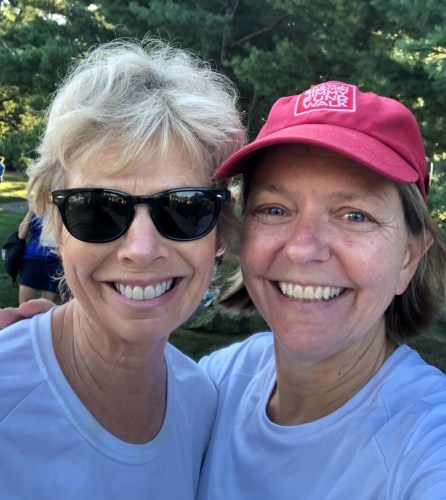 As we stood side by side on Diane’s front porch after the walk Sunday afternoon, surrounded by friends and family, champagne glasses raised in remembrance of our friend, I was struck by both the sadness and the rightness of things. Life goes on.
As we stood side by side on Diane’s front porch after the walk Sunday afternoon, surrounded by friends and family, champagne glasses raised in remembrance of our friend, I was struck by both the sadness and the rightness of things. Life goes on.
And I am humbled by all of it. Perhaps growing up, growing old, even growing wise simply means finally, fully appreciating the miracle of being here. Maybe it also means recognizing, at last, that the vast, eternal rhythms at work in the world are holy, mysterious, and forever beyond my own limited understanding.
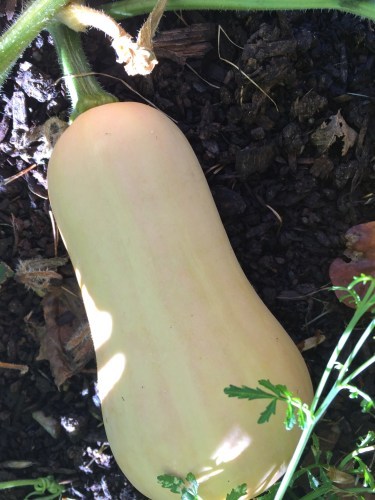 How to explain the alchemy by which a flat, tan seed tucked into the dirt last spring can produce by September half a dozen miniature butternut squash hidden under veiny, dinner-plates sized leaves? (I crouch to do my daily head-count, as if checking on a litter of kittens, and there they are, their perfect, tawny skins as smooth as silk.)
How to explain the alchemy by which a flat, tan seed tucked into the dirt last spring can produce by September half a dozen miniature butternut squash hidden under veiny, dinner-plates sized leaves? (I crouch to do my daily head-count, as if checking on a litter of kittens, and there they are, their perfect, tawny skins as smooth as silk.)
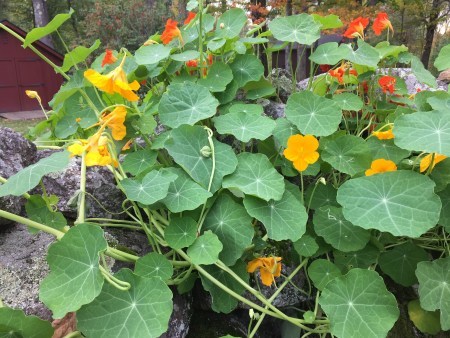 How to account for the miracle by which the nasturtium vine, product of its own shriveled seed, rambles now, sprawling with blossoms, across twenty feet of stone wall?
How to account for the miracle by which the nasturtium vine, product of its own shriveled seed, rambles now, sprawling with blossoms, across twenty feet of stone wall?
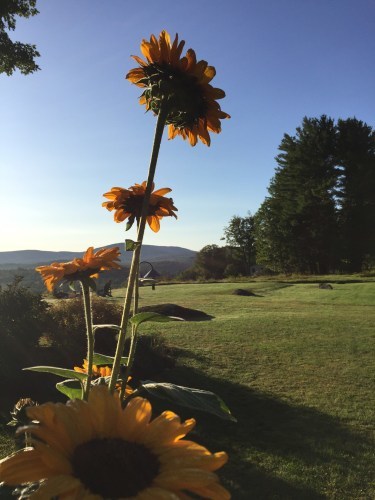 What can I do but bow my head before the height of a sun-flower, or offer prayers of thanks for the taste of a peach?
What can I do but bow my head before the height of a sun-flower, or offer prayers of thanks for the taste of a peach?
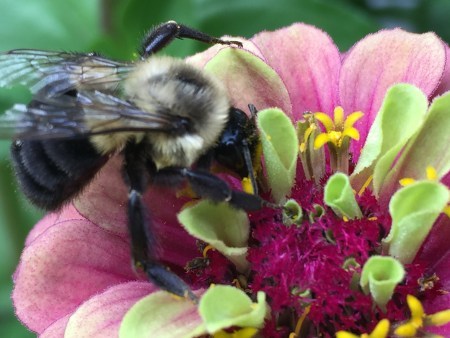 And isn’t it my own foolish loss if I fail to gaze in awe at the many-petaled zinnia, the industry of the bee, the color of the leaf at my feet?
And isn’t it my own foolish loss if I fail to gaze in awe at the many-petaled zinnia, the industry of the bee, the color of the leaf at my feet?
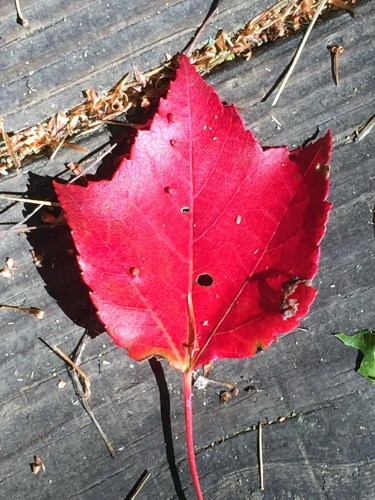 As a child, I took all this for granted, as if the world existed for my use and pleasure. Now, a week shy of sixty-one, the existence of every living thing fills me with amazement.
As a child, I took all this for granted, as if the world existed for my use and pleasure. Now, a week shy of sixty-one, the existence of every living thing fills me with amazement.
Last fall, Debbie and I scattered hundreds of milkweed seeds in the part of the field we’ve begun to leave unmowed. Over the last few years, left mostly to its own devices and with just a little help from us, this tangled patch has slowly transformed itself into a wild mix of goldenrod, Queen Anne’s lace, and black-eyed Susans, all exuberantly self-sowing and threading themselves through the grasses. The milkweed took root and grew and thrived. The first monarch appeared in June, surprising us with its early arrival. And then at dusk one night a few weeks later we stood and watched as an army of striped caterpillars hungrily feasted on milkweed leaves.
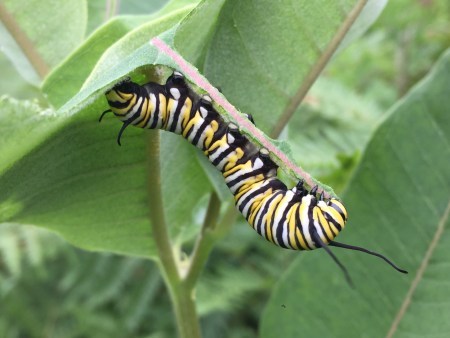 When my two sons were little, a September afternoon meant butterflies to watch. Just twenty years ago there were estimated to be over a billion monarchs in North America alone. Now, thanks to Round-Up, the loss of habitat, the effects of climate change on their wintering grounds in Mexico, and the disappearance of milkweed from the roadsides and fields of the land, the butterflies are at risk of extinction. Scientists estimate a population slashed to 93 million, with most of those survivors in the Northeast. It’s a small thing we’re doing here, growing milkweed for the monarchs, but there’s nothing that’s given us more joy this summer than seeing the success of our crop and the return of the butterflies. Plant milkweed, it seems, and they will come – at least for this year.
When my two sons were little, a September afternoon meant butterflies to watch. Just twenty years ago there were estimated to be over a billion monarchs in North America alone. Now, thanks to Round-Up, the loss of habitat, the effects of climate change on their wintering grounds in Mexico, and the disappearance of milkweed from the roadsides and fields of the land, the butterflies are at risk of extinction. Scientists estimate a population slashed to 93 million, with most of those survivors in the Northeast. It’s a small thing we’re doing here, growing milkweed for the monarchs, but there’s nothing that’s given us more joy this summer than seeing the success of our crop and the return of the butterflies. Plant milkweed, it seems, and they will come – at least for this year.
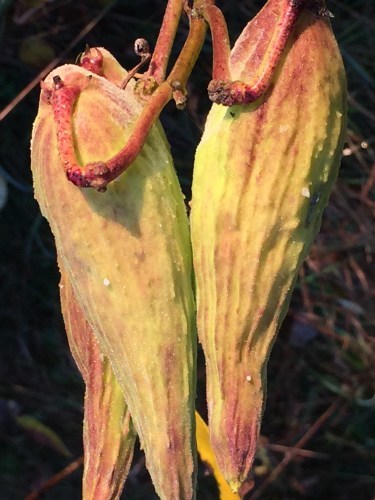 There’s much in this world beyond my ken and out of my control. The devastating reports arrive weekly it seems — the loss of birds, of bees, the damage to the oceans, the Trump administration’s aggressive roll-back of environmental protections that have been in place for years. And I’ve given in often of late to feelings of helplessness, grief, and anger. But it is also in our human nature to lean toward hope. And so, as I pay ever closer attention to subtle changes in my own backyard, I remind myself to also keep watch for goodness. It exists.
There’s much in this world beyond my ken and out of my control. The devastating reports arrive weekly it seems — the loss of birds, of bees, the damage to the oceans, the Trump administration’s aggressive roll-back of environmental protections that have been in place for years. And I’ve given in often of late to feelings of helplessness, grief, and anger. But it is also in our human nature to lean toward hope. And so, as I pay ever closer attention to subtle changes in my own backyard, I remind myself to also keep watch for goodness. It exists.
On this unseasonably warm first day of fall, 2019, a sixteen-year-old girl eloquently addressed the United Nations’ Climate Action Summit, demanding that world leaders begin to deal with climate change as the emergency we and they all know it to be.
On this first day of fall, the chorus of voices insisting that our morally corrupt president be impeached grew stronger and louder.
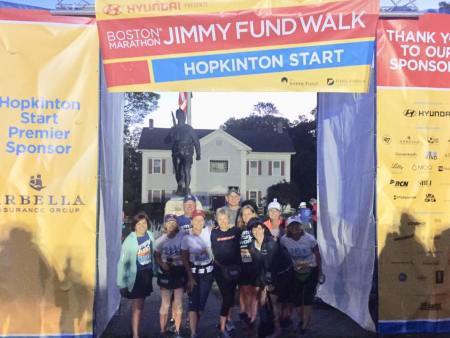 On this first day of fall, Team Diane in its ninth year added up our funds and donated over $28,000 to Dr. Ursula Matulonis and her crew of researchers at Dana Farber.
On this first day of fall, Team Diane in its ninth year added up our funds and donated over $28,000 to Dr. Ursula Matulonis and her crew of researchers at Dana Farber.
On this first day of fall, my son Henry, who has been struggling in his first year of college teaching, called to report that he’d had a pretty good day.
On this first day of fall, I am standing in my garden as the sun goes down, remembering dear friends who are gone and counting monarch butterflies. There are six, nine, more.
At last, a little late, I make my way down to the back patio where Debbie has been waiting for me.
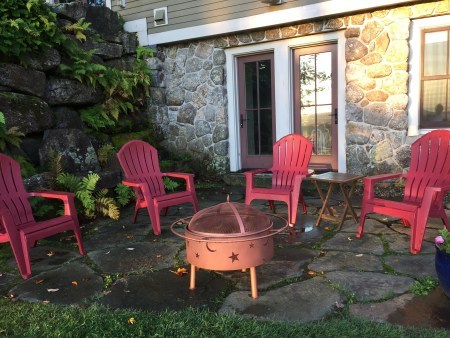 “Sit down,” she instructs, “and tell me what you see.”
“Sit down,” she instructs, “and tell me what you see.”
I see a bluebird perching on the birdhouse, a flock of sparrows lifting and settling in the tall grass, a hawk floating on a current far above our heads, the mountains turning violet in the reflected light of dusk.
“Look closer,” Debbie says, and I do.
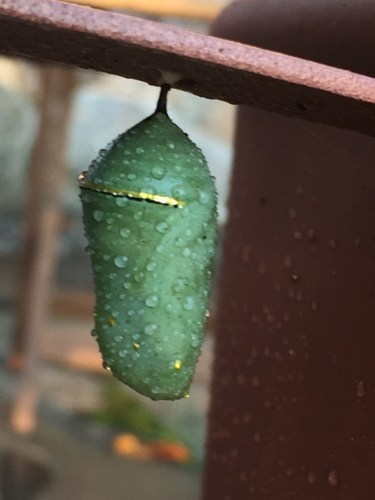 There, right in front of my chair, dangling from the rim of our metal fire pit, is a tiny celadon chrysalis, perfect as a jewel. On this first day of fall, life goes on. Blessed are we.
There, right in front of my chair, dangling from the rim of our metal fire pit, is a tiny celadon chrysalis, perfect as a jewel. On this first day of fall, life goes on. Blessed are we.
ONE OR TWO THINGS”
1
Don’t bother me.
I’ve just
been born.
2
The butterfly’s loping flight
carries it through the country of the leaves
delicately, and well enough to get it
where it wants to go, wherever that is, stopping
here and there to fuzzle the damp throats
of flowers and the black mud; up
and down it swings, frenzied and aimless; and sometimes
for long delicious moments it is perfectly
lazy, riding motionless in the breeze on the soft stalk
of some ordinary flower.
3
The god of dirt came up to me many times and said
so many wise and delectable things, I lay
on the grass listening
to his dog voice,
crow voice,
frog voice; now,
he said, and now,
and never once mentioned forever,
4
which has nevertheless always been,
like a sharp iron hoof,
at the center of my mind.
5
One or two things are all you need
to travel over the blue pond, over the deep
roughage of the trees and through the stiff
flowers of lightning– some deep
memory of pleasure, some cutting
knowledge of pain.
6
But to lift the hoof!
For that you need an idea.
7
For years and years I struggled
just to love my life. And then
the butterfly
rose, weightless, in the wind.
“Don’t love your life
too much,” it said,
and vanished into the world.
~ Mary Oliver from New and Selected Poems: Volume One
The post first day of fall appeared first on Katrina Kenison.
May 4, 2019
death, life, both
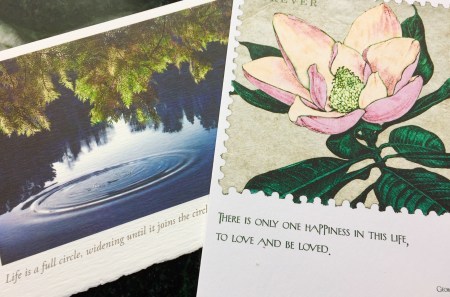 I bought two cards the other day at the stationery store in town.
I bought two cards the other day at the stationery store in town.
The 31-year-old son of a life-long friend died last weekend. The 28-year-old son of another dear friend is about to get married.
And so I sit this morning, pen in hand, my own mother’s heart overflowing. In death and in joy, we are called to pause and try to make sense of things. And yet, searching for words that might offer solace, and for words with which to honor and celebrate, I also know this: no store-bought card can begin to suffice.
A wake. A wedding. A valiant struggle with opioid addiction and a gentle young man’s life lost too soon. Two young adults preparing to join their lives together, filled with hope and determined to love, honor, and uphold a marriage’s sacred trust. A man I’ve known since we were both six grieves the death of his only son. And a friend whose children grew up alongside my own goes shopping for a mother-of-the-groom dress. I re-read the obituary. I click to enlarge the photo of the dress.
The randomness of grace and luck, of life and death, is breathtaking.
I remember a shy little boy in my third-grade class who gave me three tiny dolls as a gift, tucked into a small green tomato basket under a square of cloth his mother had stitched into a miniature blanket. That was over fifty years ago, and yet I can see them still, in my mind’s eye. Yesterday, I wrapped my arms around that same boy. He is sixty now, like me, and his own boy is gone.
I remember a long-ago September afternoon, picking raspberries with my new next door neighbor who was quickly becoming a cherished friend and confidante. The details are fresh in memory even now: our laughter and easy conversation, our children’s hands stained red with juice, the hovering thrum of wasps, the warmth of sun on bare arms. My friend’s four-year-old, who till this day had shunned all fruits and vegetables, suddenly pronounced that he loved raspberries. We cheered this breakthrough and encouraged him to eat as many as he wanted. That tiny, red-headed macaroni-and-cheese-eating child is about to become a husband. Life rushes on.
Meanwhile, we do what humans have always done. We show up for each other. We do our best to strengthen the ties that bind us on this perilous, magnificent journey. We gather to mourn, to celebrate. We shed tears of sadness, tears of joy.
“I guess lately I feel like all I can do is look back,” a young mother wrote me yesterday, “because the future seems so unclear. My children are 5, 6, and 8. We’re in the thick of it.”
Yes, I want to say to her. You are indeed in the thick of it. And there is nothing clear about the future, nor will there ever be. But you are doing beautifully, really. Just keep going.
In the entire history of the universe, let alone in your own history, there has never been another day just like today, and there will never be another just like it again.
Today is the point to which all your yesterdays have been leading since the hour of your birth. It is the point from which all your tomorrows will proceed until the hour of your death.
If you were aware of how precious today is, you could hardly live through it. Unless you are aware of how precious it is, you can hardly be said to be living at all.
~ Frederick Buechner
The post death, life, both appeared first on Katrina Kenison.



